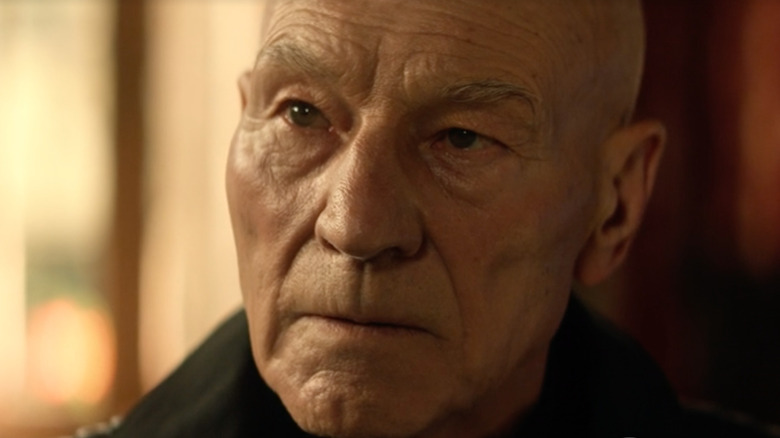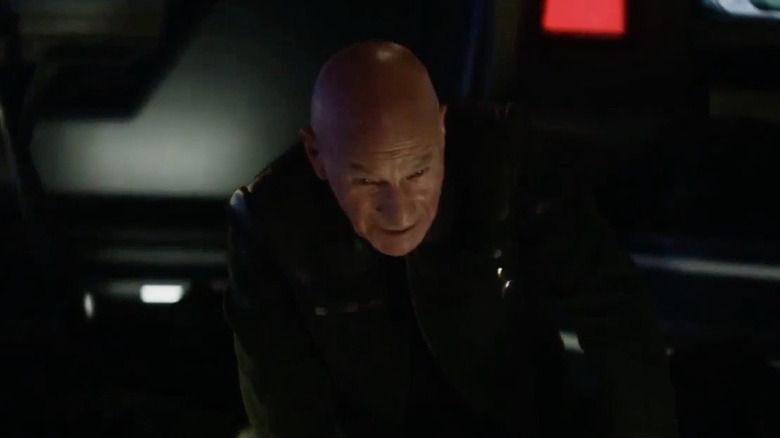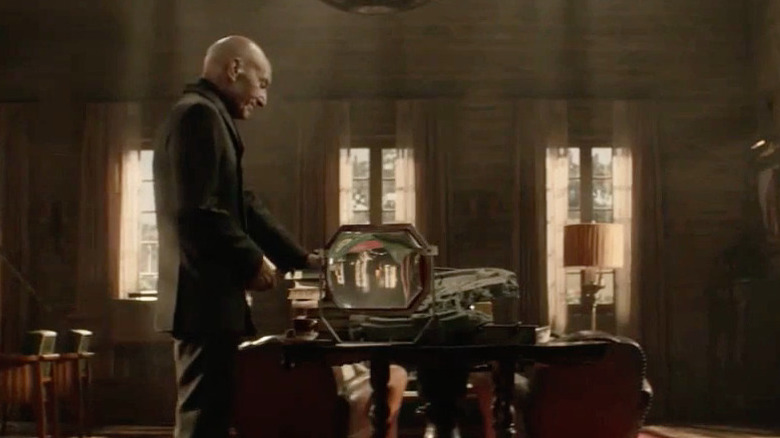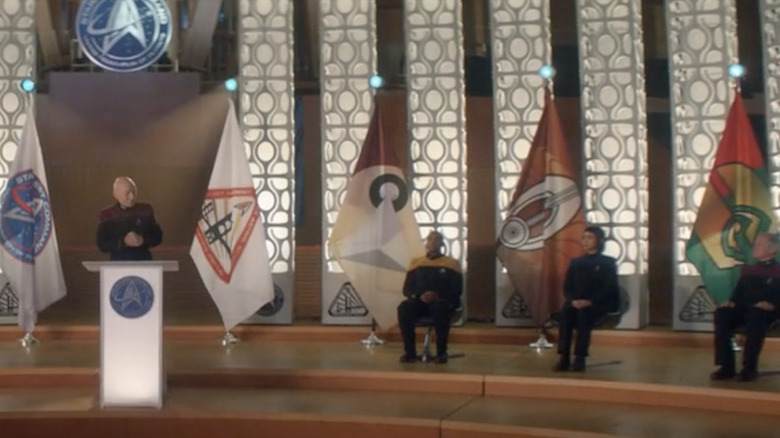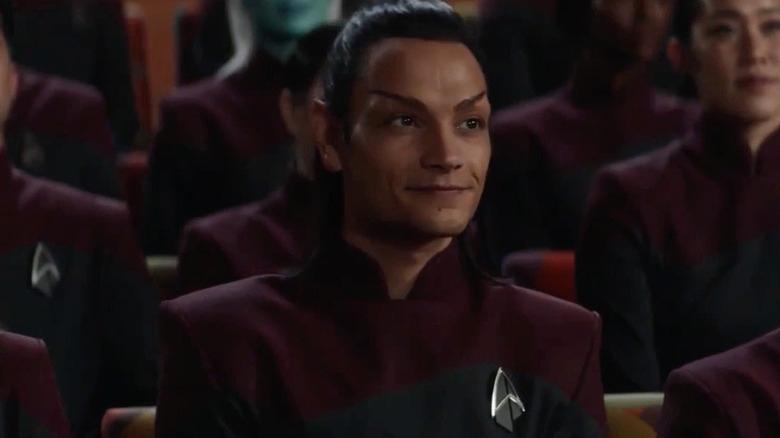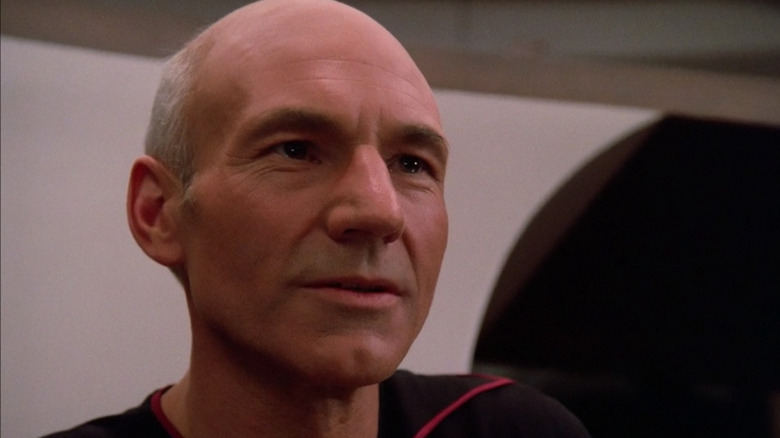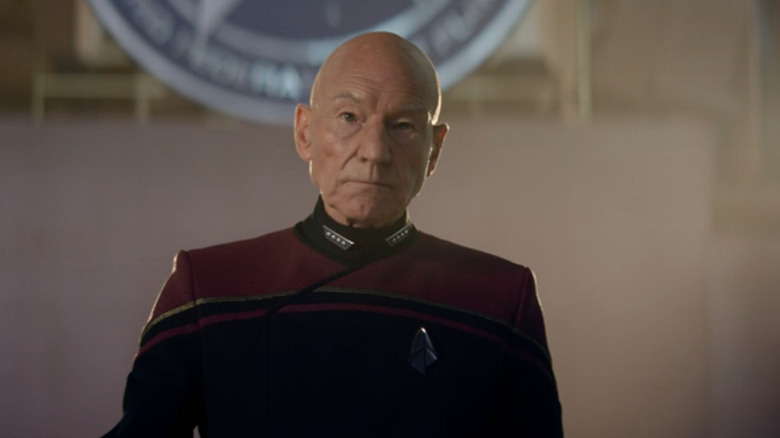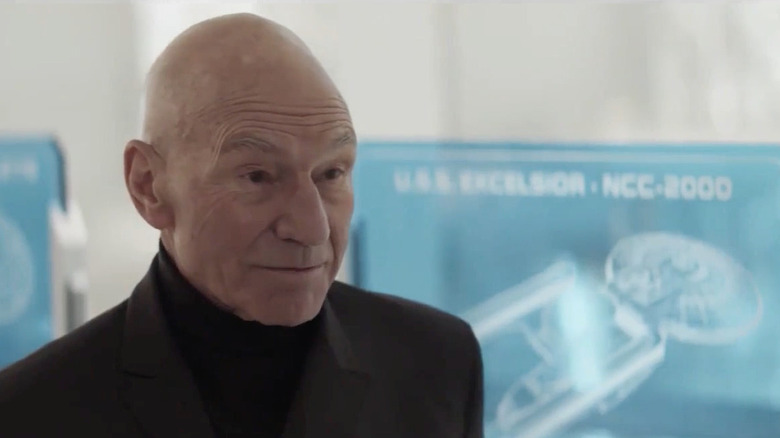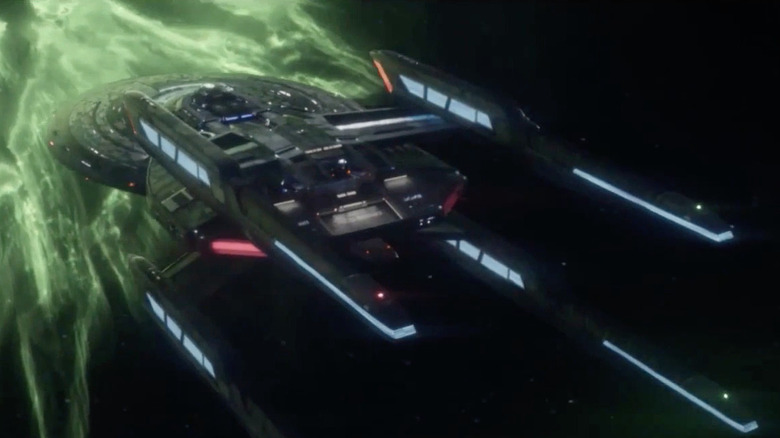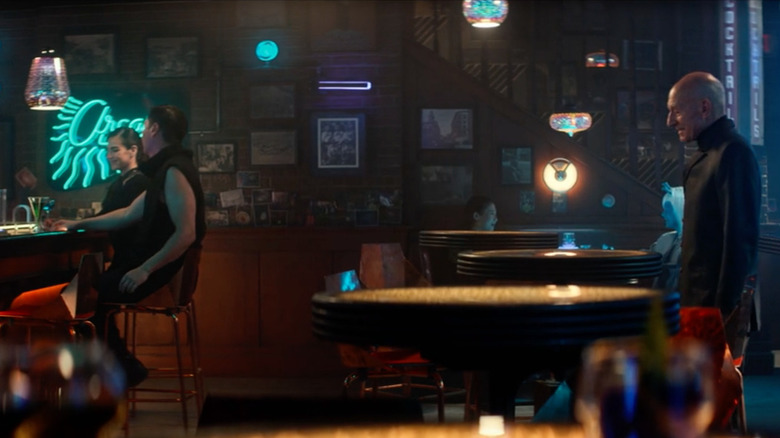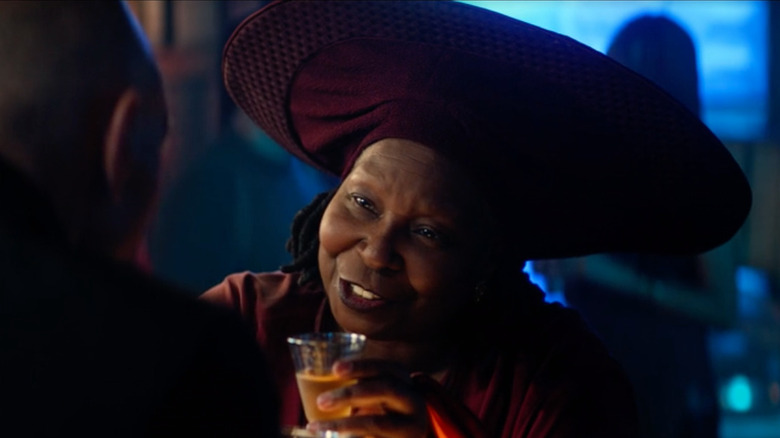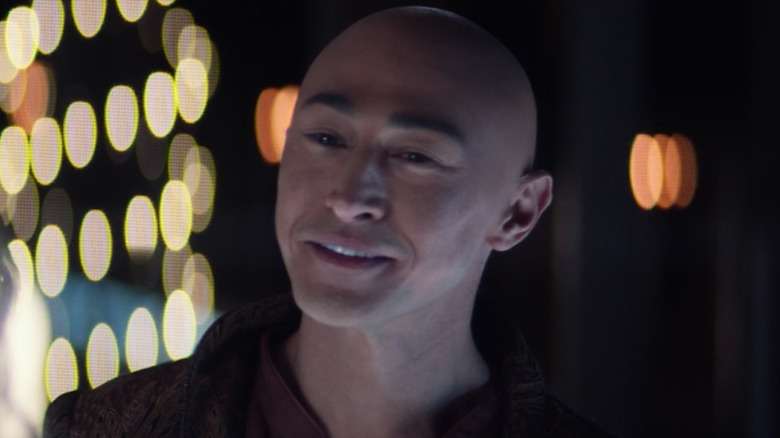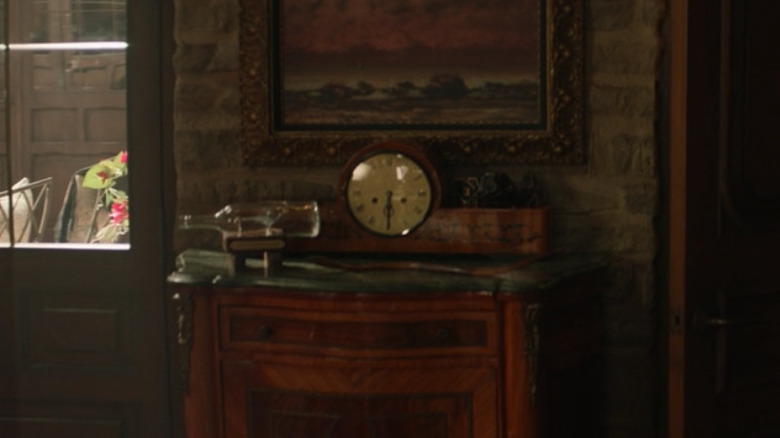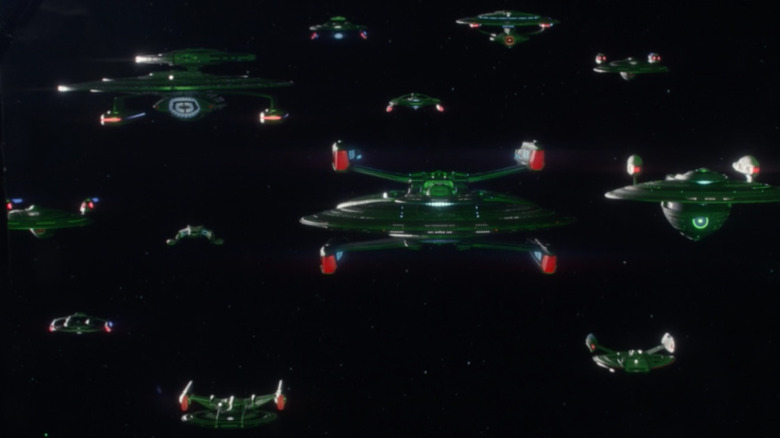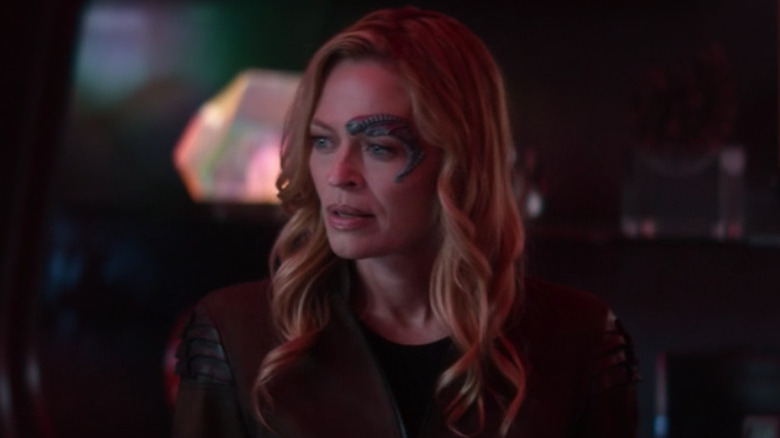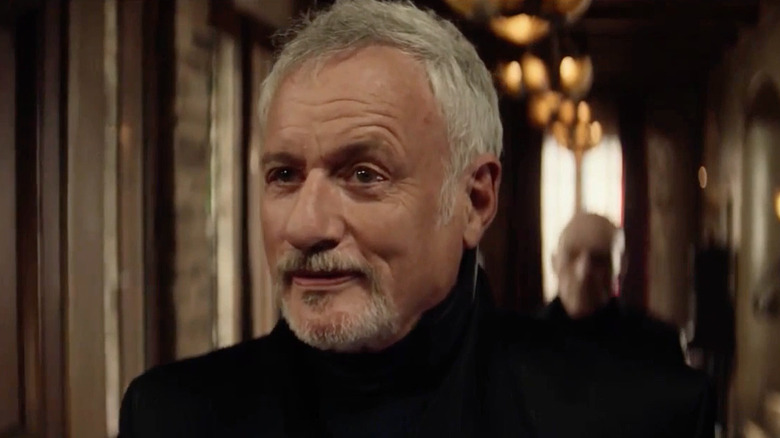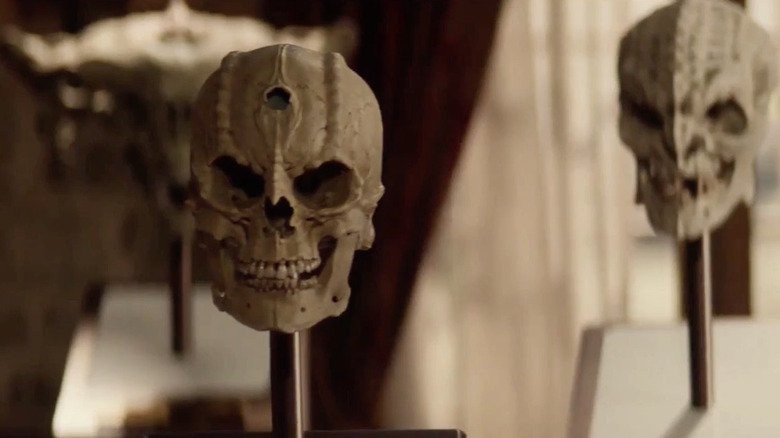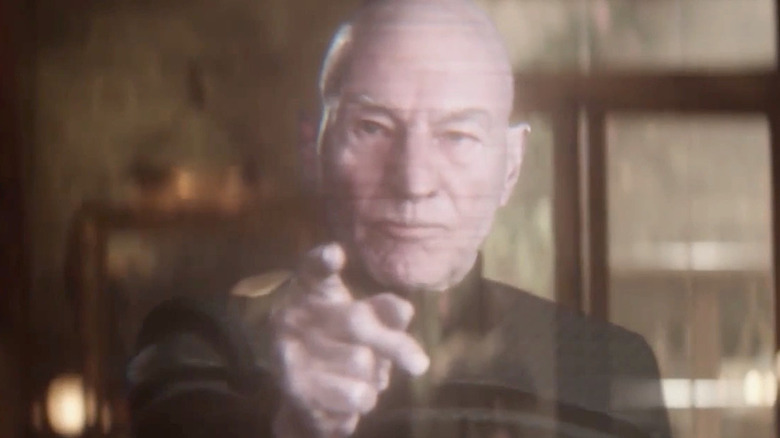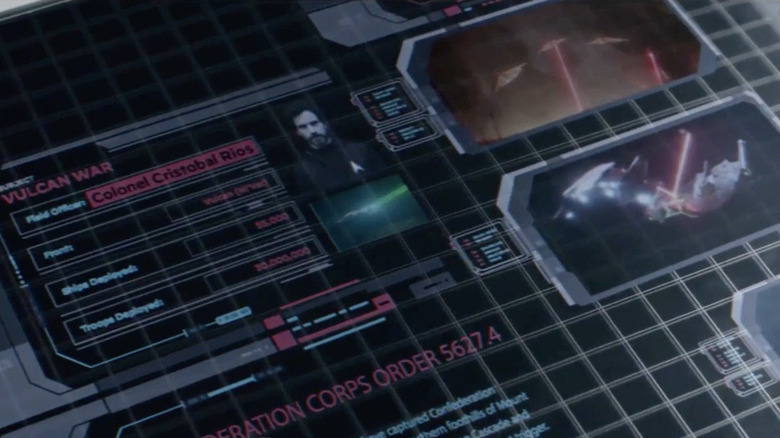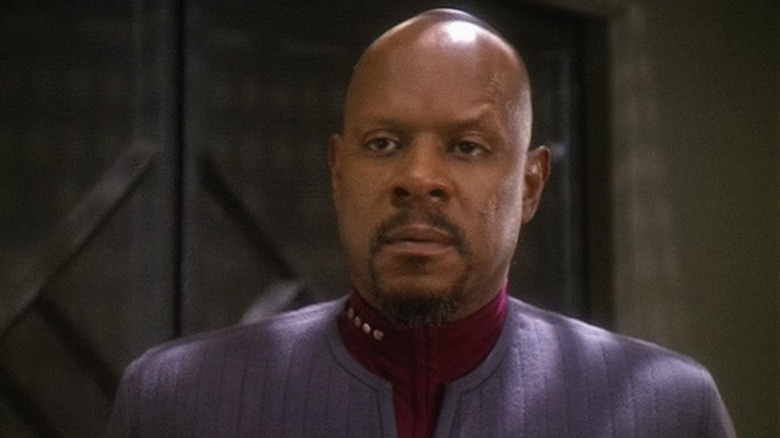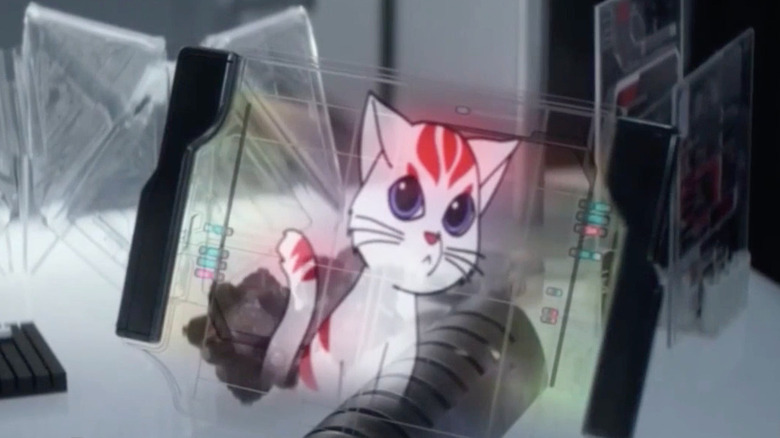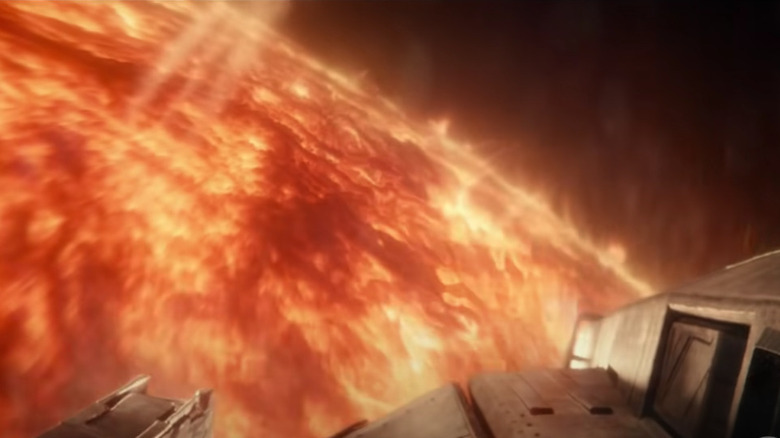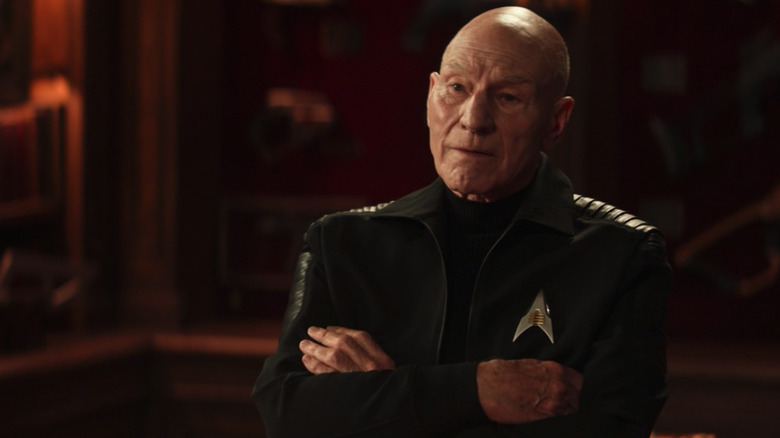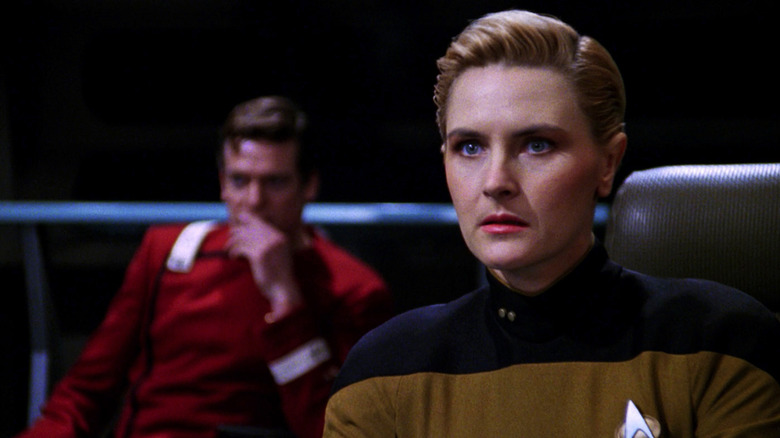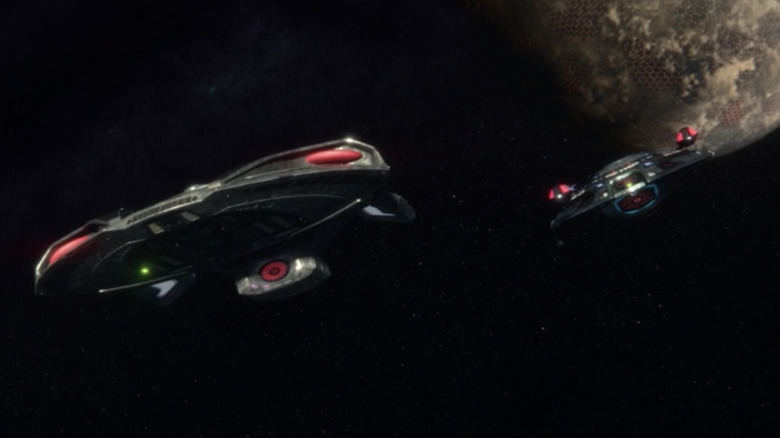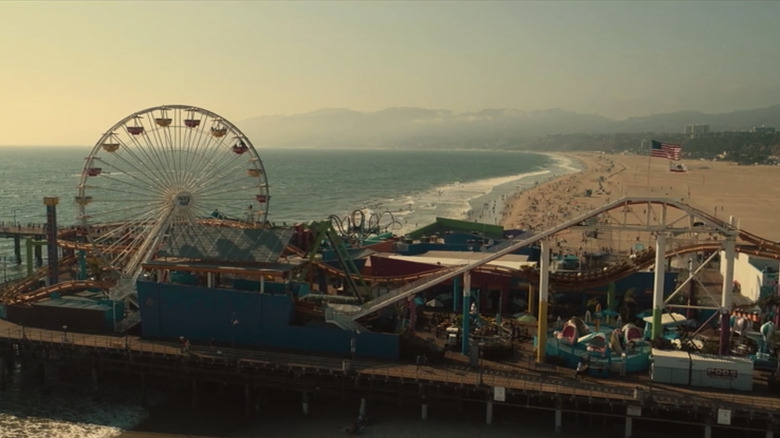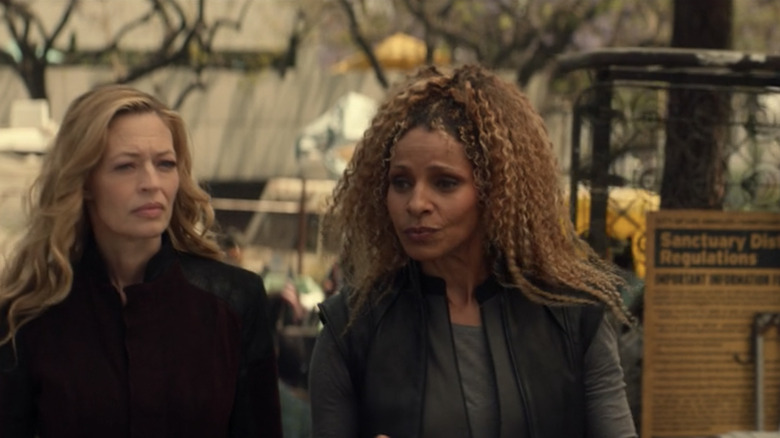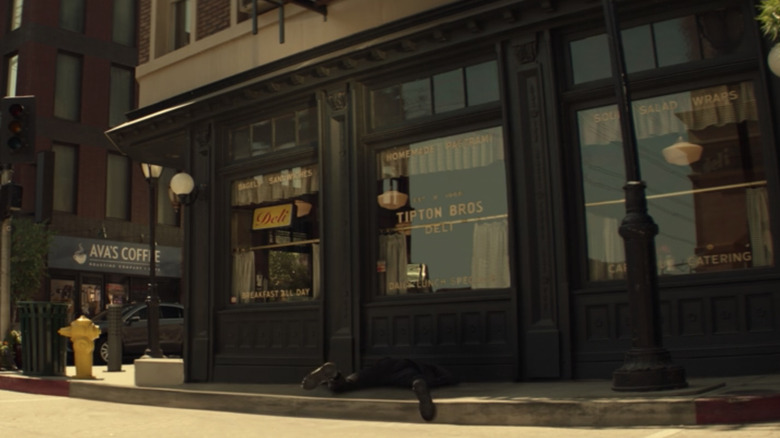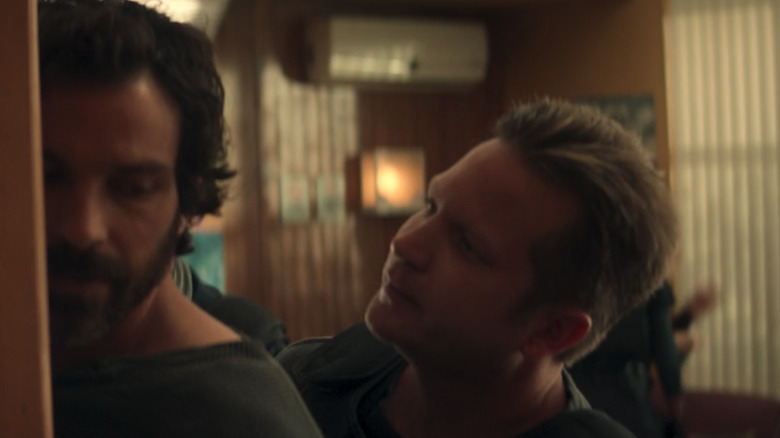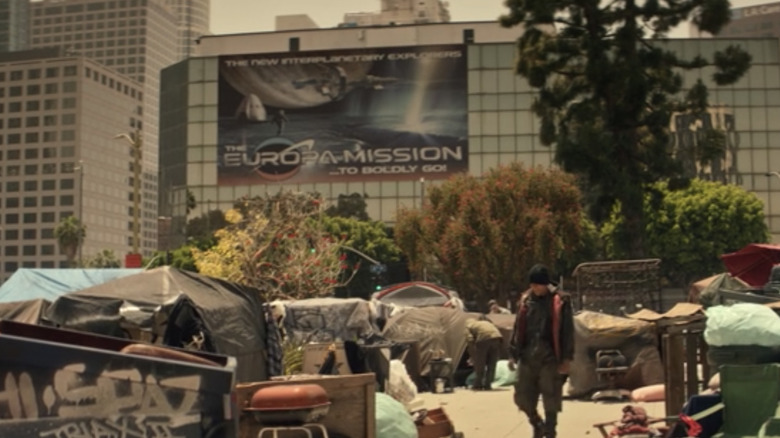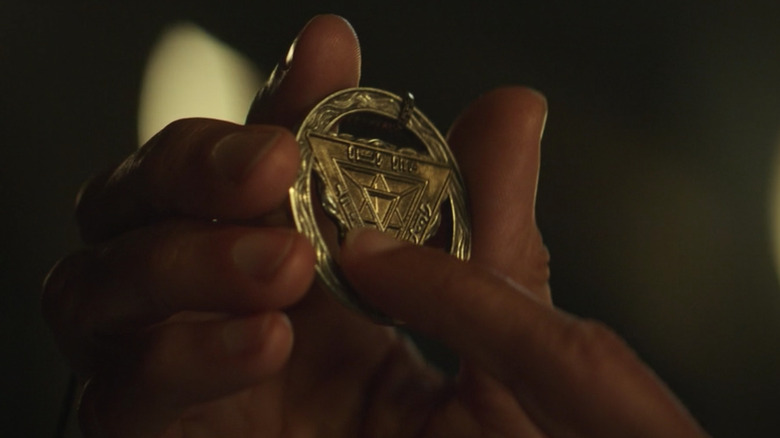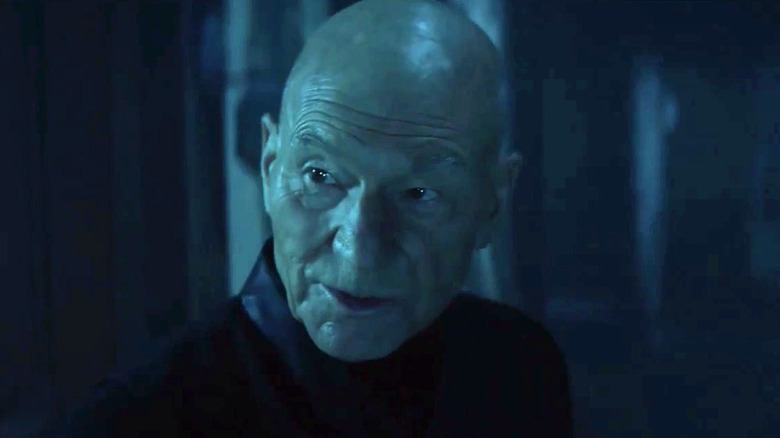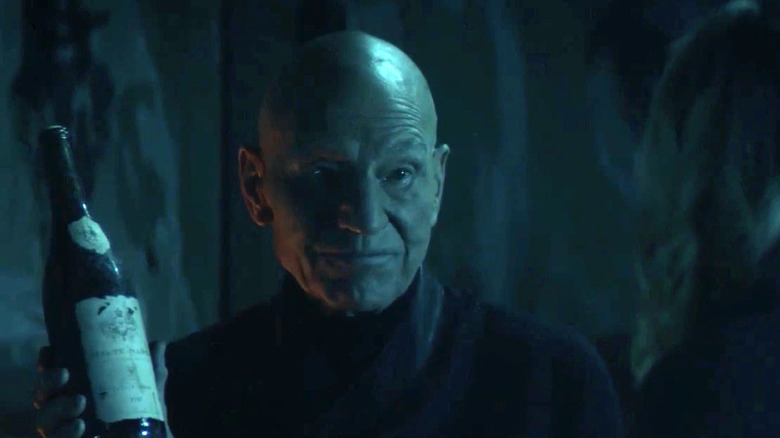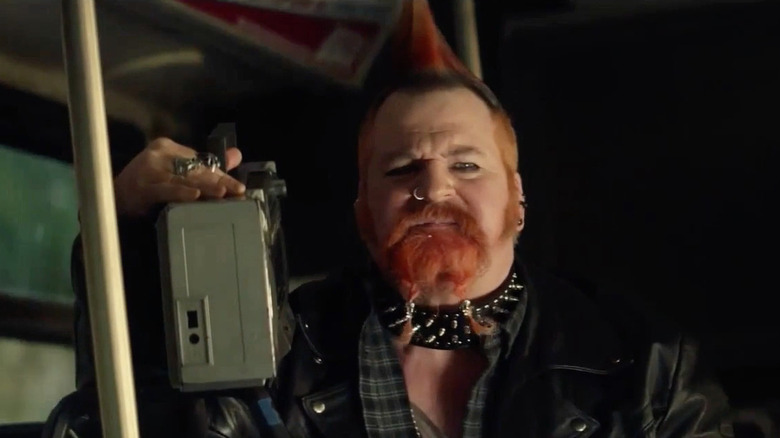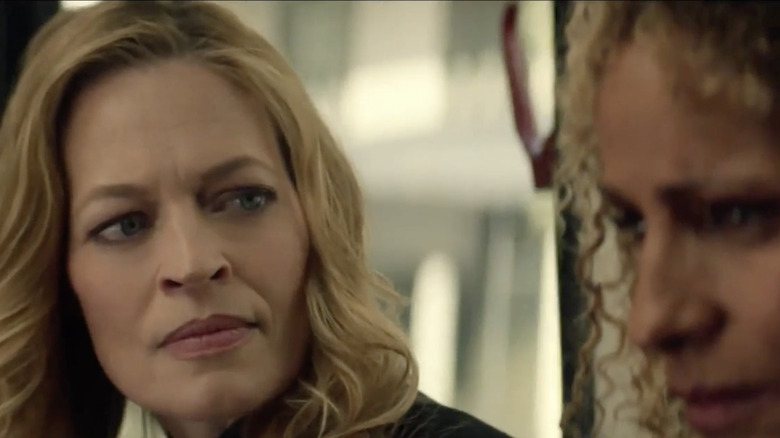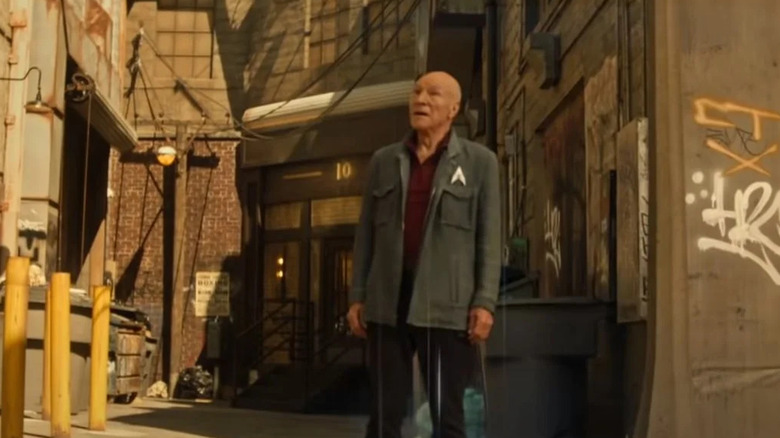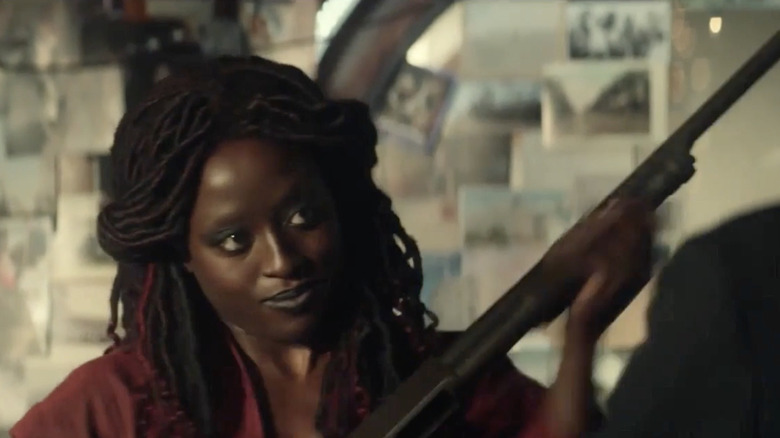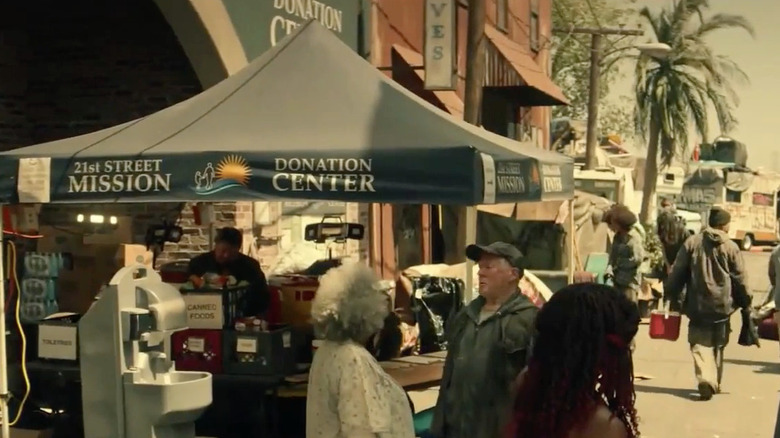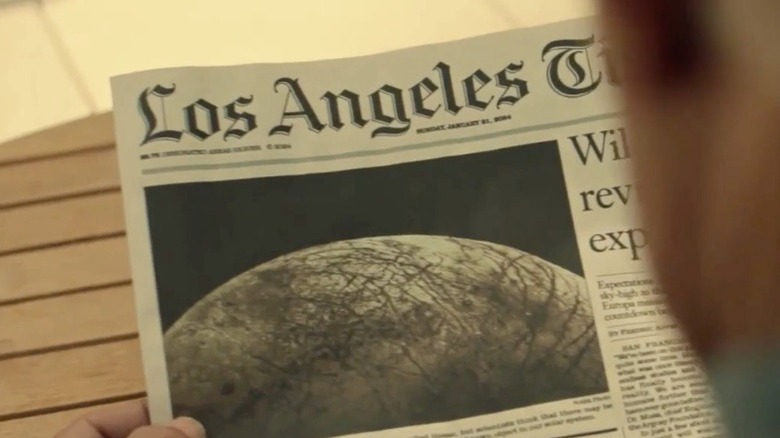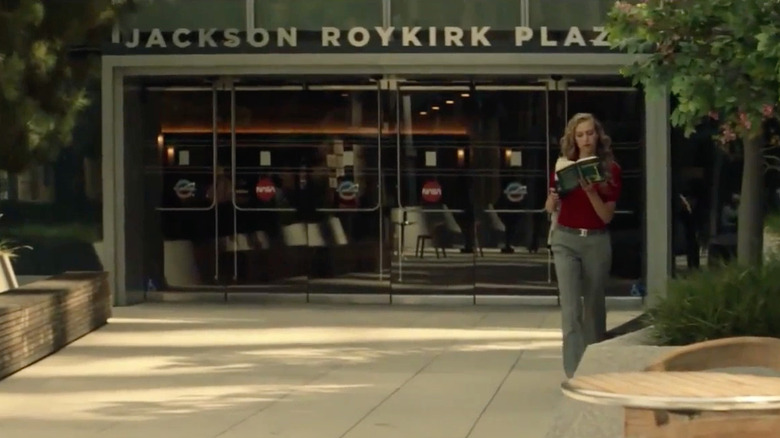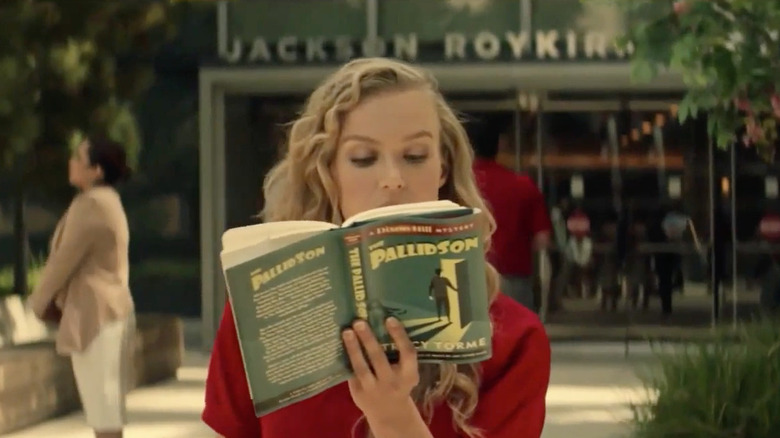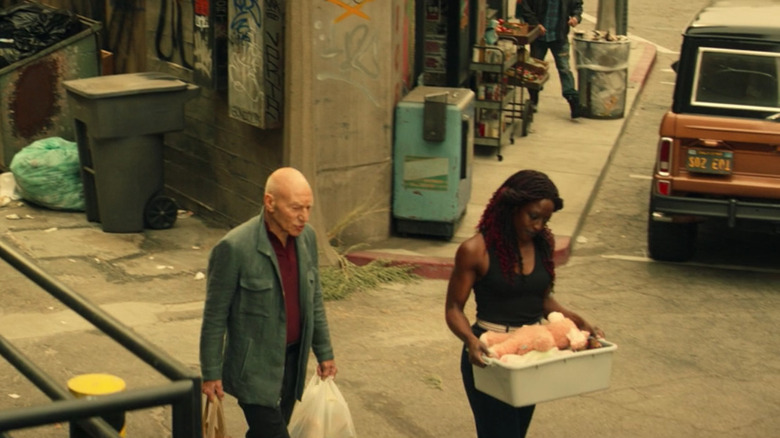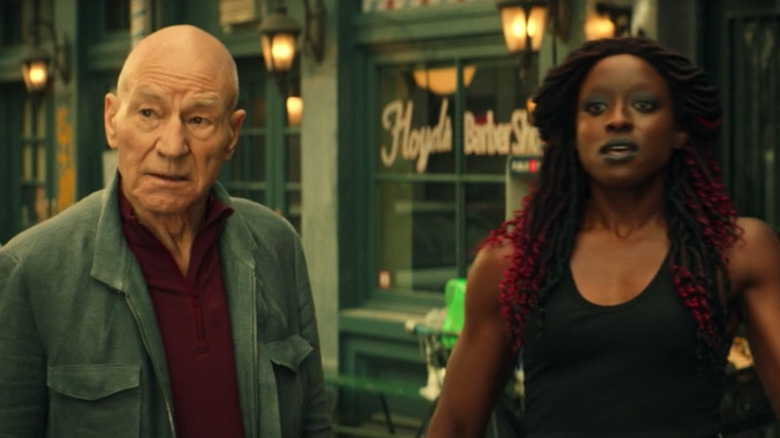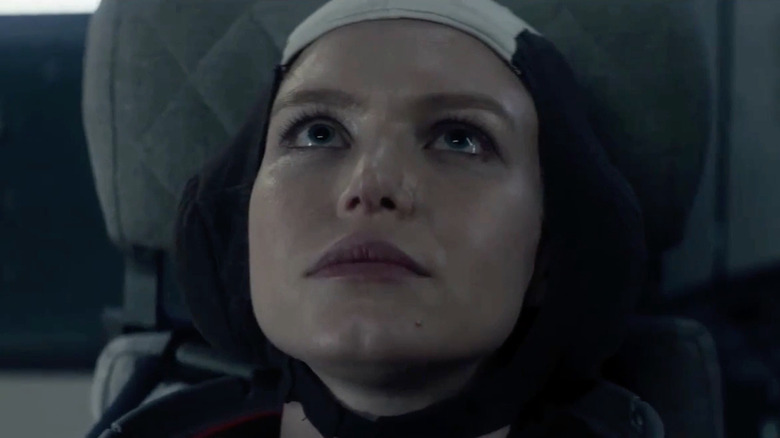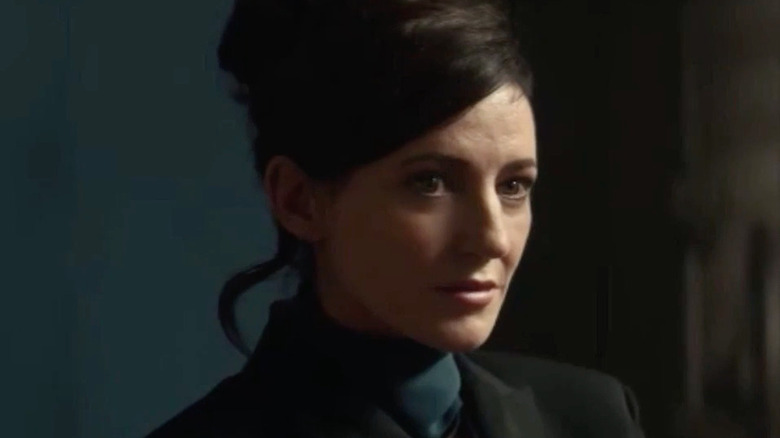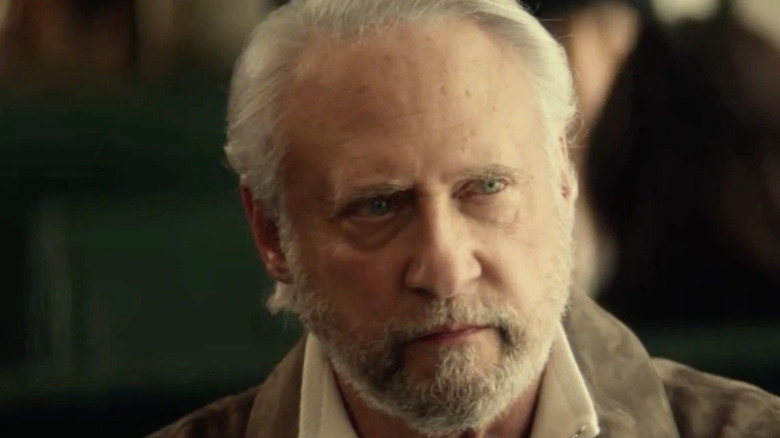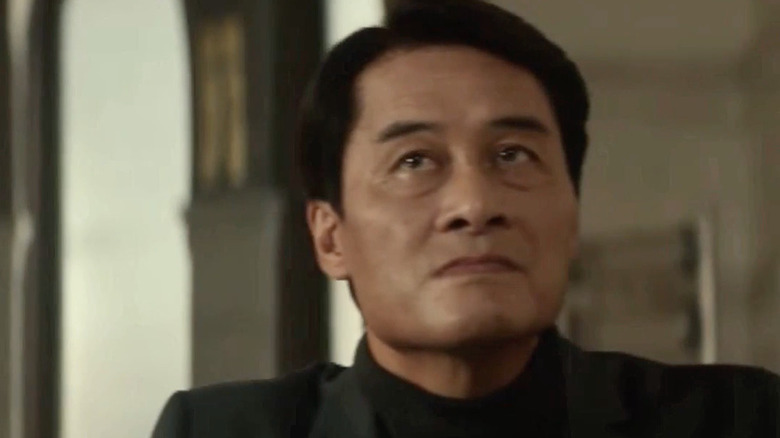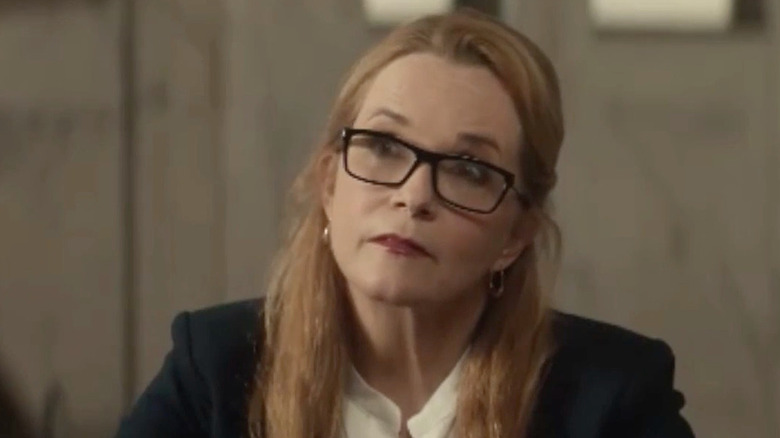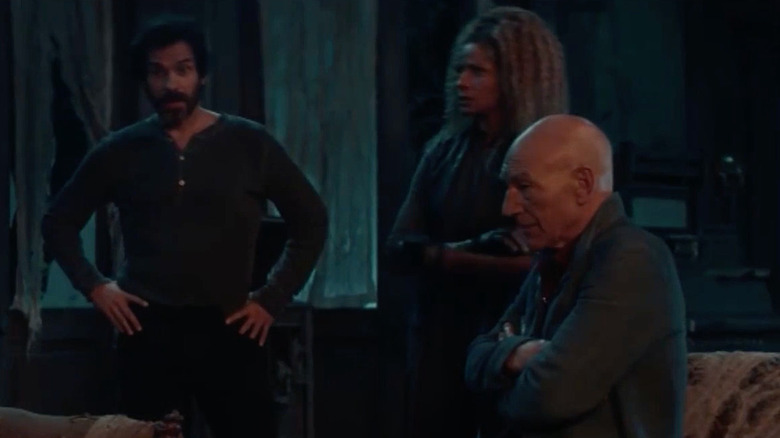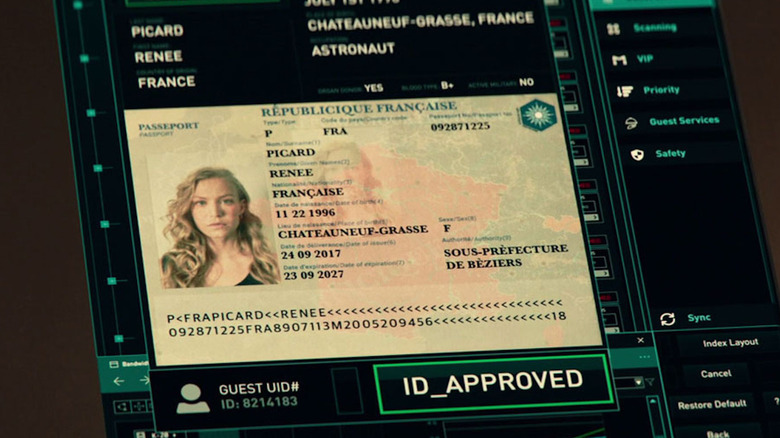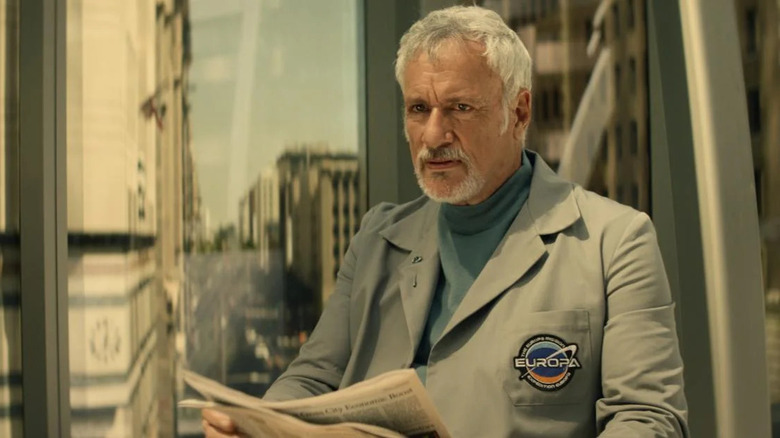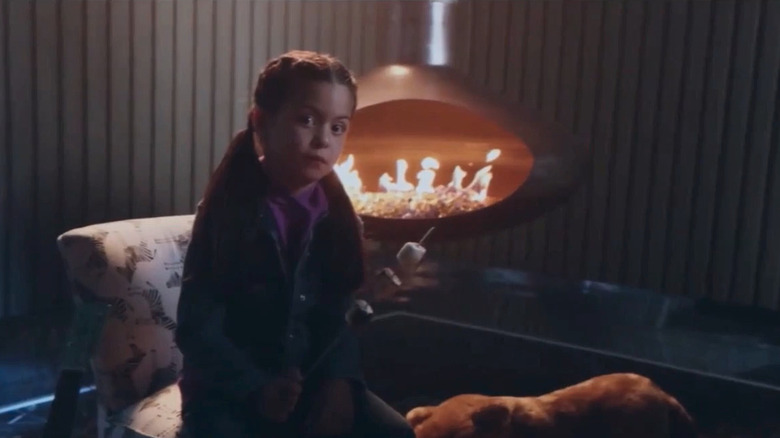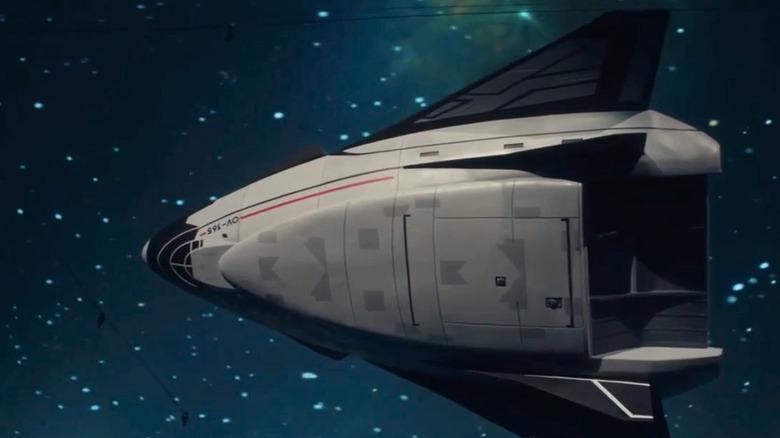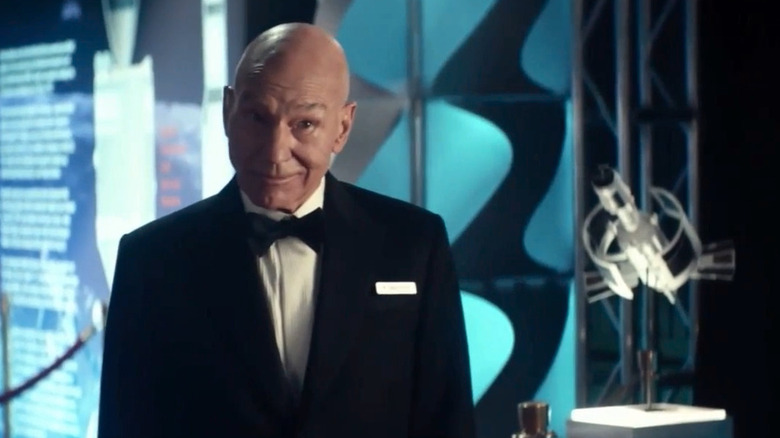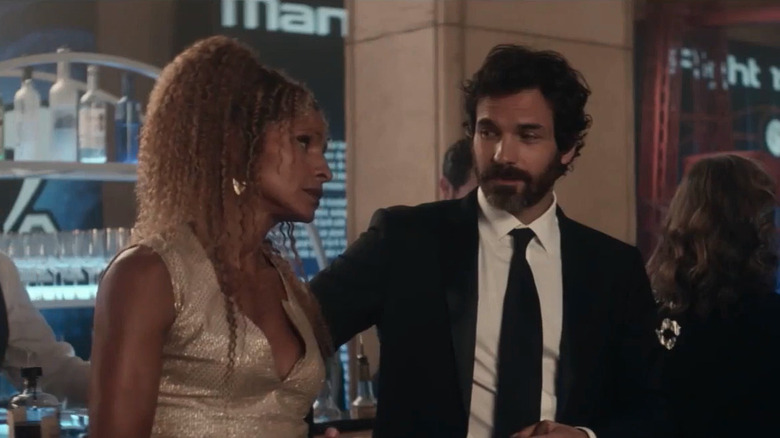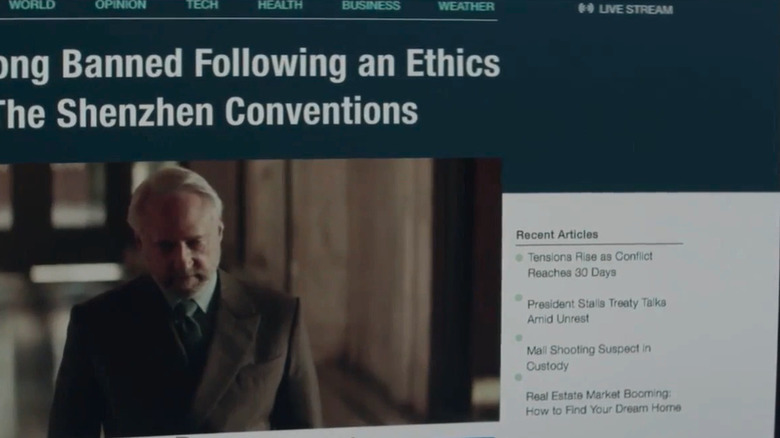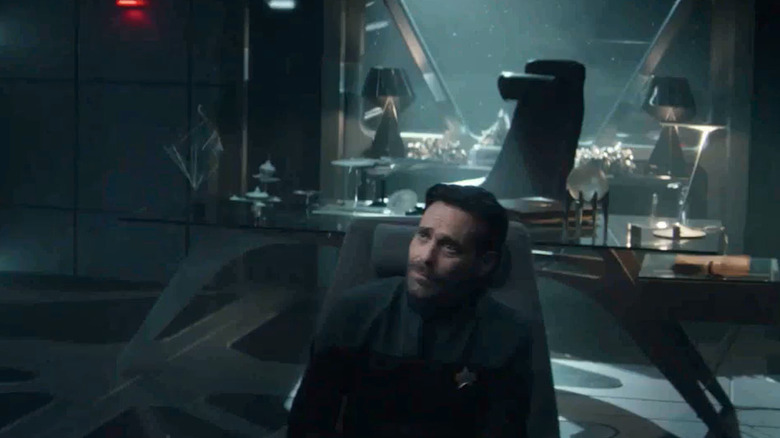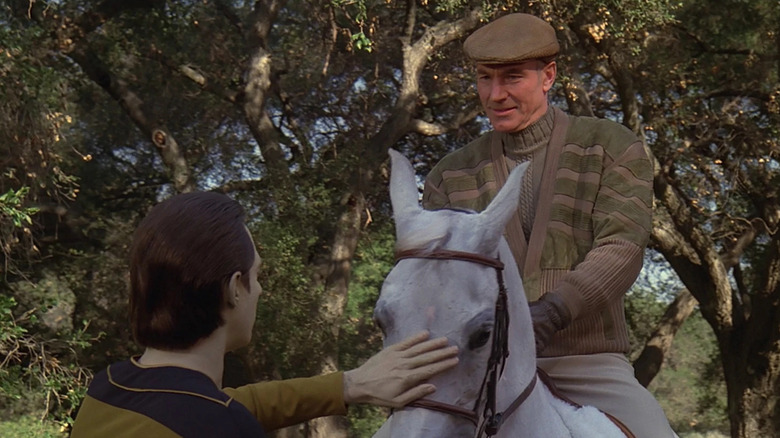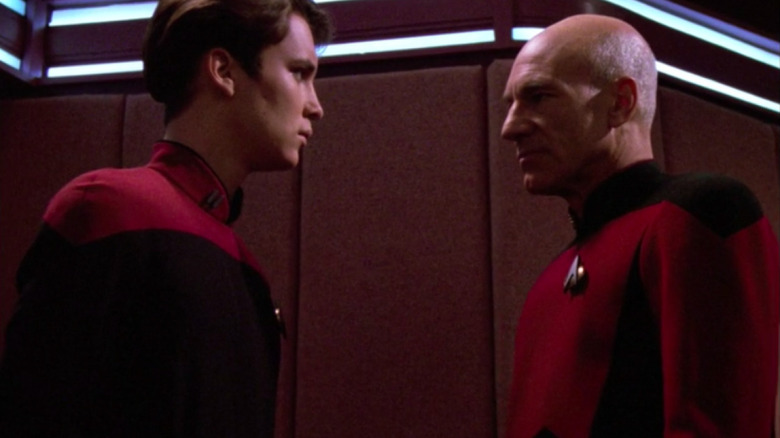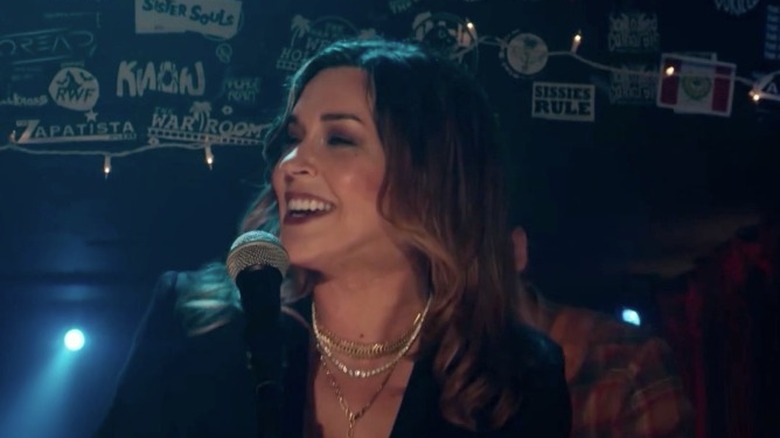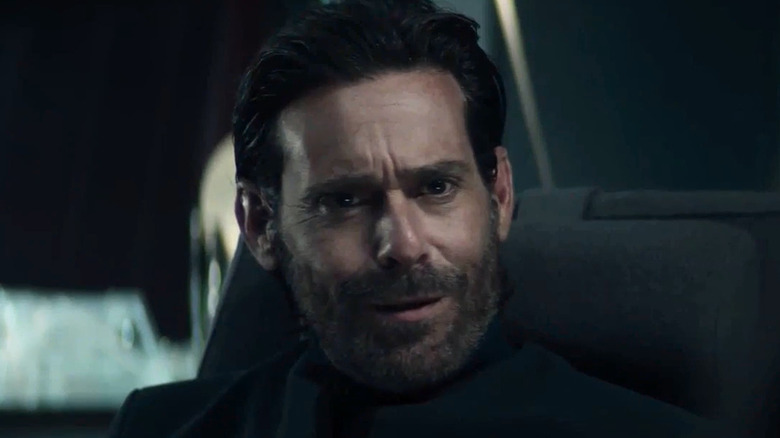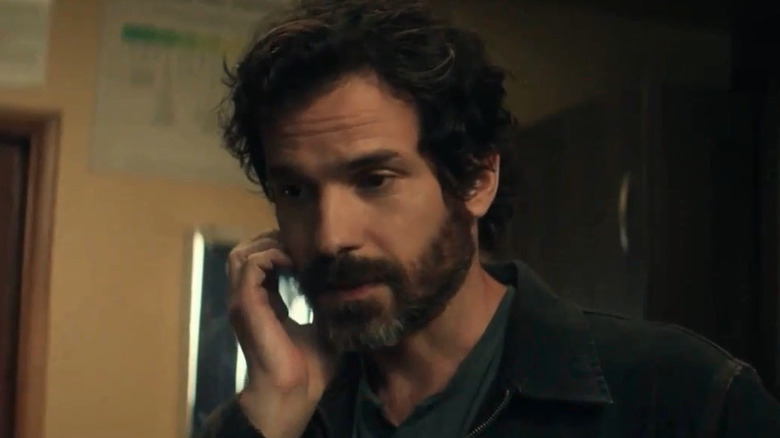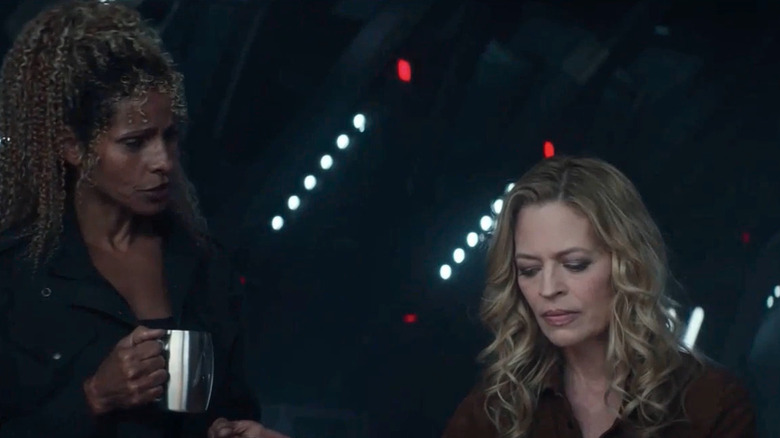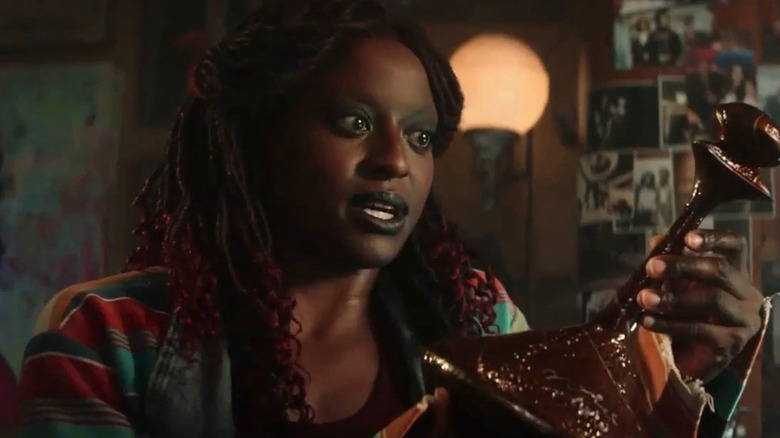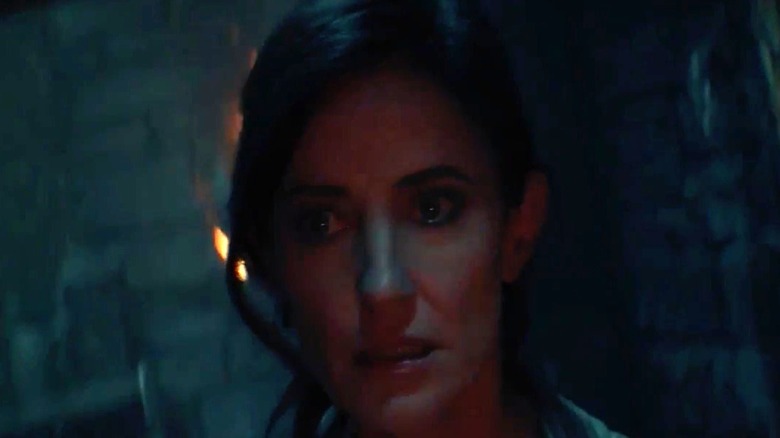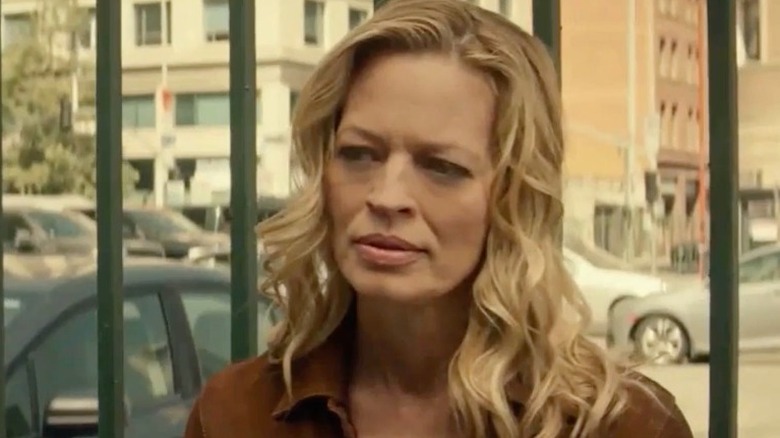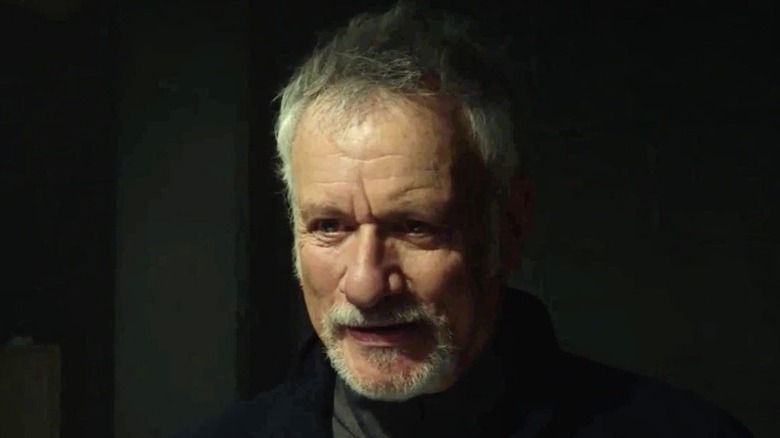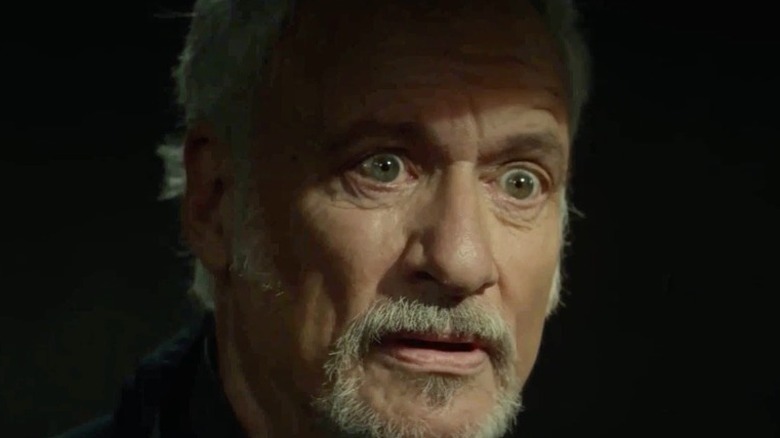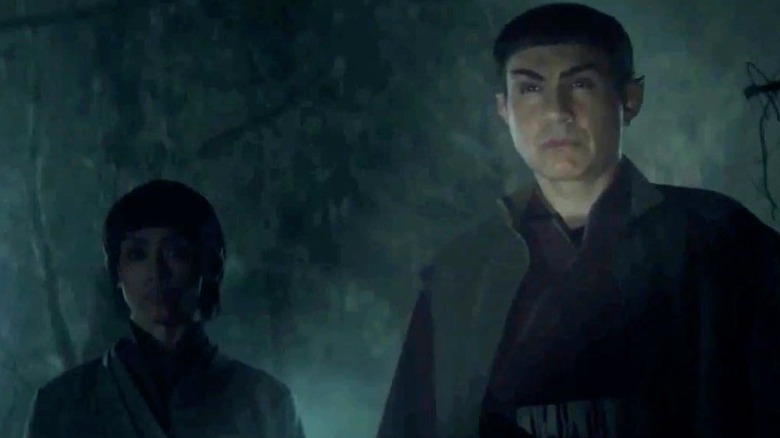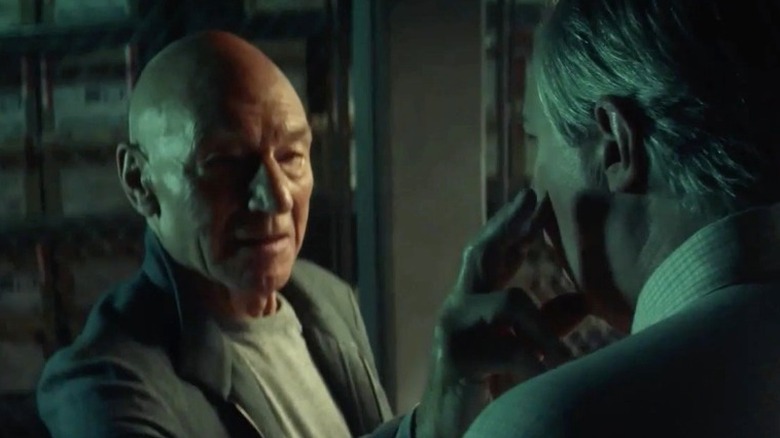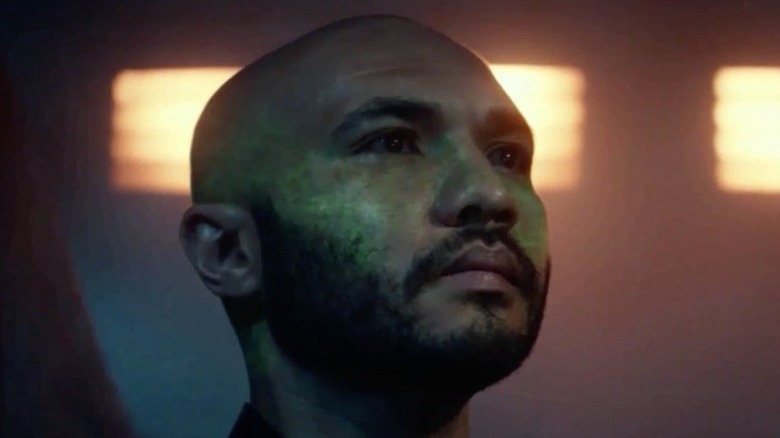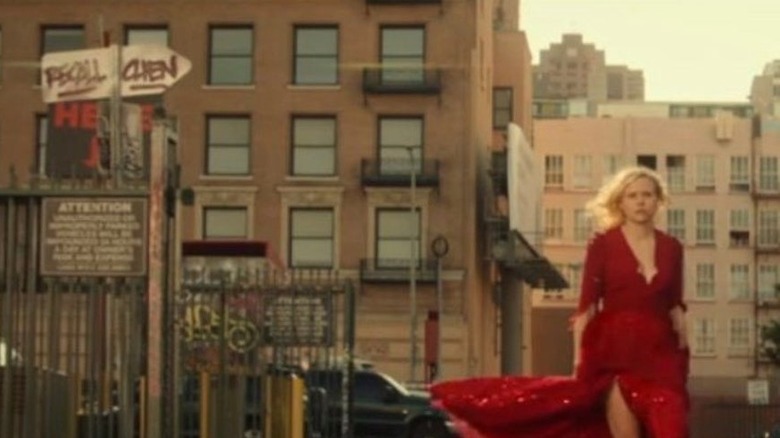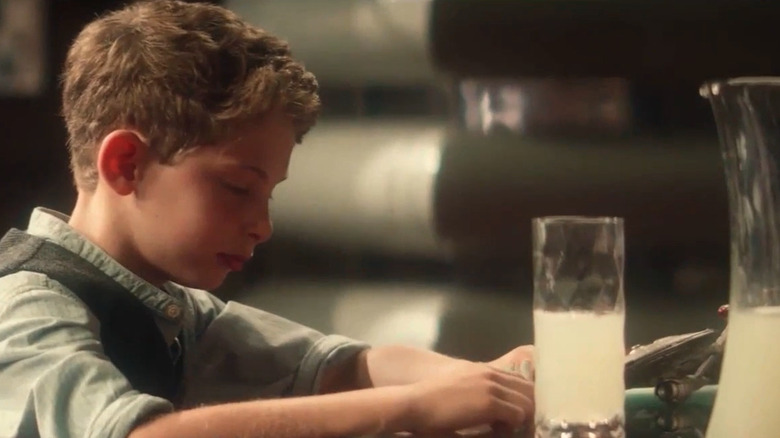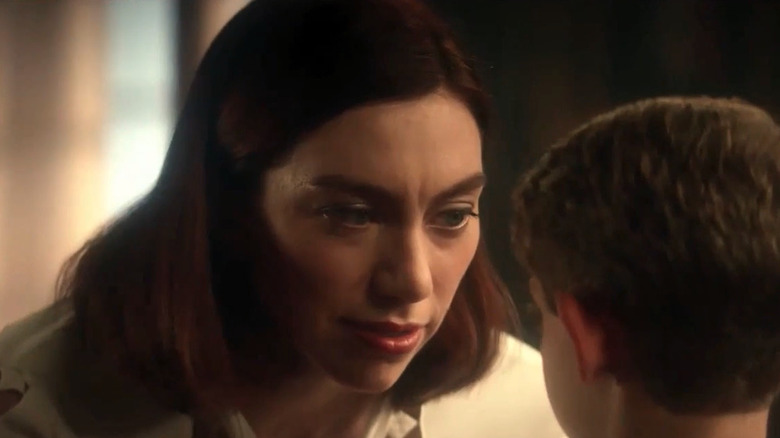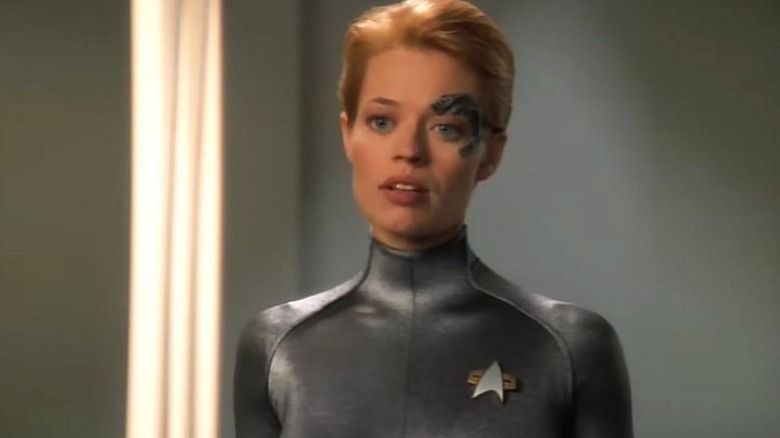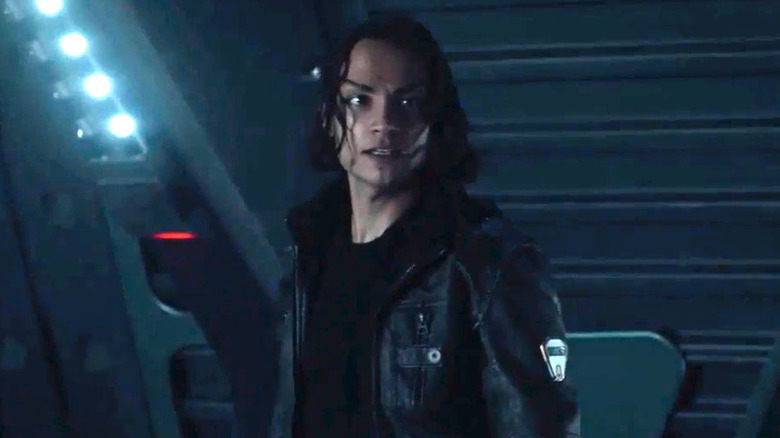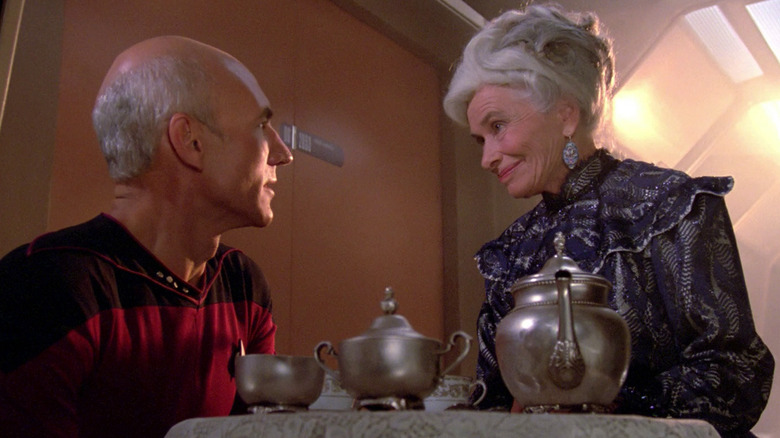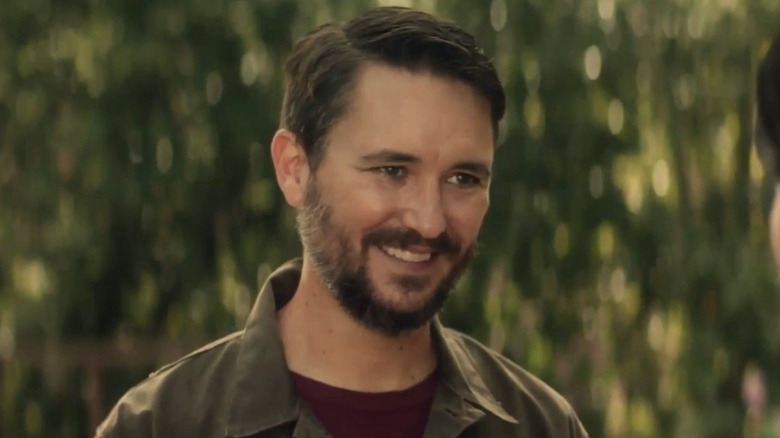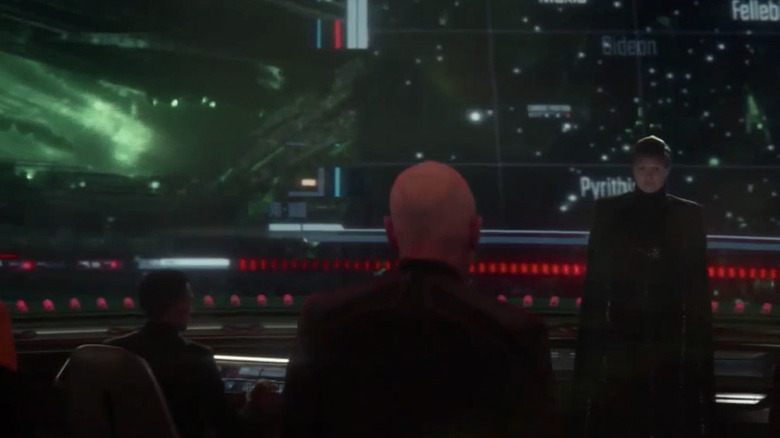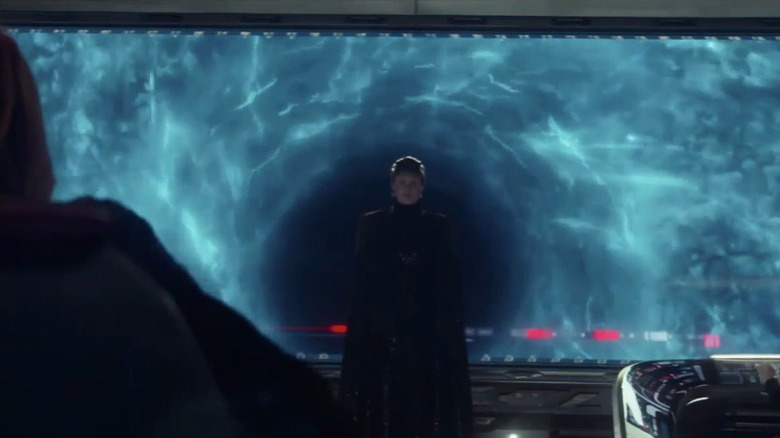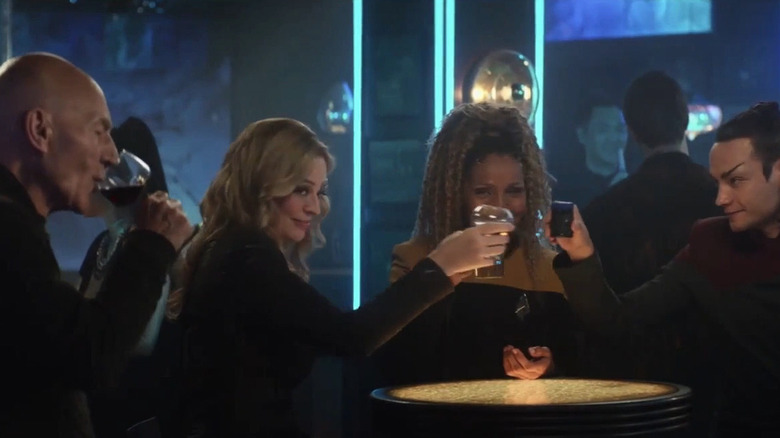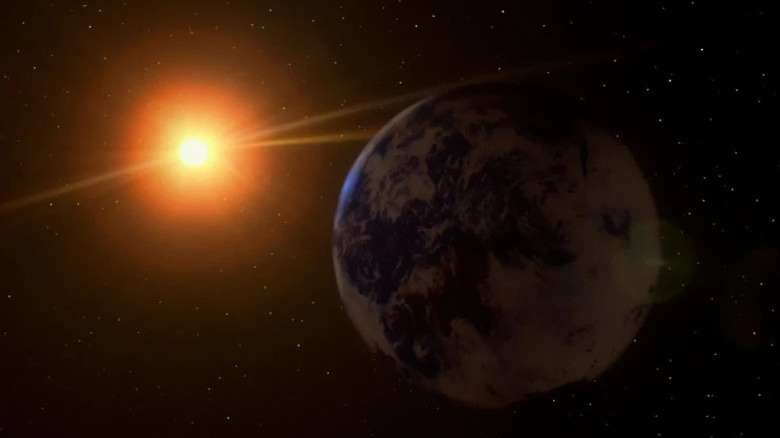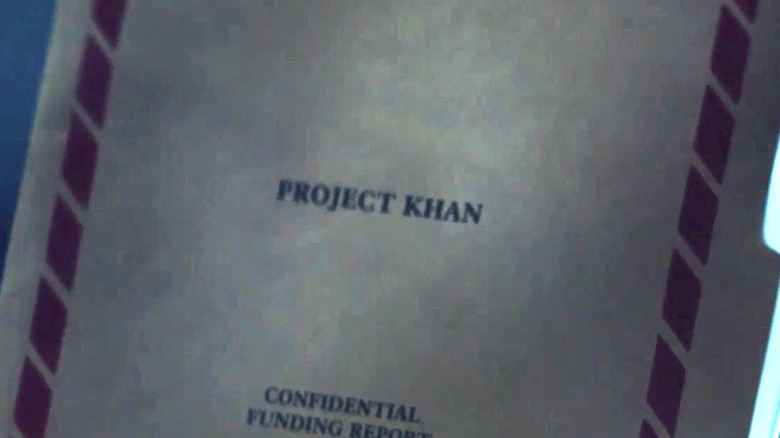Easter Eggs You Missed In Star Trek: Picard Season 2
The first season of "Star Trek: Picard" did what few thought possible: Bring back a beloved character and a star actor who had long moved on from his role as captain of the Enterprise, and continued his adventures into the new millennium. It had been nearly 20 years since we'd seen him Jean-Luc Picard, and while there had been plenty of "Star Trek" in that time, "Picard" still managed to offer up something new and daring, with plenty of surprises. But it was also filled with loads of callbacks, from the surprise inclusion of "Voyager" fan favorite Seven Of Nine to plot threads that tied back to an unexpected classic episode.
Season 2 of "Picard" picks up right where the first left off, and ups the stakes. From the first trailer, we knew the show would be reminiscent of classic "Trek" stories, including a dark parallel reality and time travel into the past. The return of the powerful trickster Q and the Enterprise's longtime barkeep Guinan showed that this season was going to have plenty of references to adventures of "Trek" past.
As such, the new season is loaded with Easter eggs. Here's a list of our favorites so far — especially ones that might have escaped your notice.
Picard's auto-destruct gambit
The premiere episode of "Picard" Season 2 opens in media res, with Starfleet officers scurrying through the corridors in the middle of what appears to be a battle aboard a starship. Arriving on the bridge, things aren't looking good, as an unseen villain is tapping into the ship's systems and appears to be gaining control. Unable to overpower the enemy, Picard commands the ship's computer to activate the auto-destruct sequence. We later learn the enemy is the Borg, and longtime fans will note this isn't the first time that Picard has had to order self-destruct due to a Borg invasion. It is, however, a major change from his previous behavior, and shows he's learned a lesson from a certain former Klingon security chief.
In the 1996 film "Star Trek: First Contact," the Borg had infiltrated the Enterprise and had controlled more than half the ship. Picard's trusted officer and friend, Lieutenant Commander Worf, recommended they self-destruct the ship to prevent its total takeover. Picard adamantly refused to destroy it, and it wasn't until he got a lecture from Lily that he relented and set the ship to self-destruct. This time, it seems, Picard is much quicker to respond, having learned that when the Borg take over, sometimes it's best to activate the ship's auto-destruct system right away.
The Bajoran reckoning tablet
As many eagle eyed viewers noticed in the first trailer for the new season, a major piece of "Deep Space Nine" lore appeared prominently on the table in Picard's library. Surrounded by books, it appeared that the former Enterprise captain — an avid archeologist — was studying the object, known as the Reckoning Tablet. The tablet made its first and only appearance in the "Deep Space Nine" episode "The Reckoning" and was smashed to pieces by Captain Sisko after receiving a vision. In doing so, he released the villainous Pah-wraiths that were locked in a centuries long war with the Bajoran Prophets.
Many wondered if the appearance of the tablet was an Easter egg just for trailers, perhaps as a nod to his past friendship with Bajoran officer Ensign Ro, or just a sly nod to "Deep Space Nine." But the tablet does indeed appear in the opening episode. As Picard and Laris speak in his library, it appears on the table between them in the center of the screen, and it is still in pieces. There's a viewing glass above it, which that suggests Picard has indeed been studying it. Given its prominence in the scene, we're forced to wonder if it's more than just an Easter egg, and perhaps a hint of more to come.
The new United Federation of Planets
As the first episode transitions to Picard's speech at Starfleet Academy, we see Picard — in his new role as Chancellor of the Academy — standing before a group of incoming Cadets. Behind him is a series of flags, presumably of Federation member worlds. That's notable because there's a number of flags from worlds who weren't members of the Federation during "The Next Generation."
While we do see flags for the Tellarites and Vulcans, who were founding members, we see a Klingon flag as well. Longtime allies of the Federations since at least the days of "TNG," it seems they could now be full members of the UFP. We also see the Bajoran flag, indicating that Bajor may have finally gained membership following "Deep Space Nine." But the most curious is Ferengi flag. Though Ferenginar was on its way to change, with the appointment of the less greed-focused Rom as their Grand Nagus at the end of "Deep Space Nine," it's curious that they'd be a Federation member so quickly.
If these aren't the flags of Federation members, then it's possible these are simply the flags of worlds from which Starfleet Academy has found cadets — meaning the Ferengi flag is a reference to the character Nog, the young Ferengi who attended the academy and served aboard the Defiant on "Deep Space Nine."
The first fully Romulan Cadet
During his speech, Picard is proud to introduce his friend Elnor — the young swordsman raised by the Qowat Milat — as the first "fully Romulan" entrant into Starfleet Academy. This indicates that, at some point prior to the events of the episode, the Academy had admitted other cadets with at least partial Romulan ancestry. It's notable also because there has been at least one Starfleet officer that we've seen whose bloodline could be traced to Romulans: A crewman named Simon Tarses, from "The Next Generation" episode "The Drumhead."
Tarses was investigated for his possible role in sabotaging the Enterprise, but his real crime was lying about his parentage by claiming he was part Vulcan rather than Romulan. Ultimately, Tarses did not even attend the Academy, and chose to enlist instead. Nevertheless, it was heavily implied that there was great controversy surrounding officers who carried the blood of a Federation enemy. It remains to be seen if this will be an issue for Elnor, who vocalizes his concerns about fitting in at the Academy due to his race, though Picard's gift — a book written by Spock — should help.
'Let's see what's out there'
The "Picard" Season 2 premiere gives us a surprising glimpse into the childhood of Jean-Luc Picard, and hints that something terrible may have happened to his mother when he was young. But it's his mother's inspiring words to the young Picard, as he looked up into the night sky, that are the source of character drama in this episode. In flashbacks, we see how Yvette Picard nurtured her son's love of the stars, offering to build him an observatory of sorts on the family estate. We know from the "TNG" episode "Family" that Picard's father decried his son's choice to enter Starfleet, so it seems a fitting revelation that it was his mother who helped ignite his exploratory spirit.
But in his speech to the Academy, Picard chooses to quote his mother with a phrase that clearly has stuck with him all of his life, as they looked out to the stars above: "let's see what's out there." It's an inspiring moment, and one that affected Picard greatly, and diehard Trekkies will remember this line for its appearance in the "TNG" premiere "Encounter At Farpoint." In the closing moments of that episode, having completed their first mission, that was Captain Picard's final command to his crew as they departed the planet. It's a fine callback to a classic episode, and a clever way of giving an innocent line of dialogue an emotional context.
Familiar sights and sounds
We didn't see much of any Starfleet vessels in Season 1 — but now that audiences are brought aboard a Starfleet ship in Season 3, we see they've stayed true to the past, and for many fans it will feel like a welcome homecoming.
Throughout the second season premiere, we are given many visual and audio callbacks to the days of 1990s "Star Trek" — from the updated LCARS computer layouts, to transporter sounds used on "The Next Generation," and the comms beeps used on "Star Trek: Voyager." Trekkies will no doubt appreciate the little touches, and the lengths that new showrunner Terry Matalas ("12 Monkeys") has gone to in order to lovingly recreate the world of Starfleet that they remember.
But the biggest and best nod might the use of "The Next Generation" theme music front and center, which begins when Jurati first beams aboard Rios' starship, and reaches a crescendo when he orders them to warp. While shows like "Star Trek: Discovery" and even the first season of "Picard" had seemingly tried to step out from the pure nostalgia of "The Next Generation" and past "Trek" series, it looks like Season 2 has chosen to fully embrace it.
Ships from Trek past
Back at the Academy, Cadets await their first assignments, with an officer calling out names and ships for them to report to. One Cadet is sent to the Hikaru Sulu, clearly named for the helmsman of the original USS Enterprise, originally played by George Takei. In "Star Trek Generations," we met Sulu's daughter, who helmed the Enterprise-B — and it's clear from this new starship that her father's name has carried a powerful legacy even into the 25th century.
Other ships include the Excelsior — captained by Raffi — where Elnor is assigned, and the USS Grissom. The original Excelsior (NCC-2000, seen here in a museum of sorts) was captained by Sulu himself in "Star Trek VI: The Undiscovered Country." While it wouldn't be unprecedented if Elnor's ship were the same Excelsior, it's most likely a newer ship with the same name. The Grissom meanwhile, though not seen, was the name of the science vessel that carried Lt. Saavik and David Marcus to the Genesis Planet in "Star Trek III: The Search For Spock."
Admiral Picard also mentions to Raffi his intention to make some modifications to the Kobayashi Maru test, which is designed to evaluate an officer's decision-making skills in a no-win situation. This test has been seen several times, most famously in "Star Trek II: The Wrath Of Khan," but again in JJ Abrams' "Star Trek" reboot, and in an episode of "Star Trek: Prodigy." Counselor Troi took a different but similar test in her bid to become a full commander in the "TNG" episode "Thine Own Self."
The USS Stargazer
Though it's called out in the episode itself, and as such isn't quite an "Easter egg" in the traditional sense, we'd be remiss if we didn't talk about Rios' new ship: the USS Stargazer. The namesake is a familiar one, as it was the ship that Picard commanded prior to helming the Enterprise-D, first seen in "TNG" episode "The Battle." In that episode, it was revealed that the ship was apparently destroyed in a fight with the Ferengi while he was in command, leading to Picard's court martial. But it was rediscovered by Daimon Bok and used in a plot to exact revenge. This new Stargazer is a welcome callback to Picard's old ship, and even boasts the same four nacelle configuration.
Of course, Seven Of Nine notes that this Stargazer is also part of a new class of starships using Borg technology taken from the reclaimed cube in Season 1. This follows many stories in "Star Trek: Voyager," where Captain Janeway and Seven Of Nine would often use the ex-Borg's nano-probes to augment various systems when the need arose. Those tactics seem to have been embraced by Starfleet and implemented on a broader scale after Voyager returned to the Alpha Quadrant, and subsequent to the Borg Reclamation Project.
Guinan's bar
When Picard visits his old friend Guinan, who is now tending a bar in Los Angeles, he goes to an address that will make fans of "The Next Generation" smile: 10 Forward Street. Fans will recall the location of Guinan's bar on the Enterprise as Ten Forward, but that's hardly the only Easter egg. Look up the stairs behind Picard and you'll notice wall panels that are a perfect match for those seen in her lounge on the Enterprise.
The bar is filled with other references, too. Behind the bar, we see bottles of Cardassian Kanar from "Deep Space Nine" in its twisted bottle, and on the wall is a sign for Arcanis Lager, first seen in "Star Trek III: The Search for Spock." When the two sit down for a drink she offers up some options but selects a bottle of Saurian Brandy, a classic "Trek" ale seen many times throughout the franchise. Here she refers to it as "hooch," revealing the drink as something less than a classy top shelf spirit.
Guinan's words of wisdom
When they first meet, Picard notes that Guinan's people age slowly, and she tells him its "only if we choose to" — and that she has chosen to for the benefit of humans who dislike being reminded of their own mortality. This helps explain to audiences why the centuries-old Guinan, played by Whoopi Goldberg, looks 20 years older than the last time we saw her in "Star Trek: Nemesis." She then makes a few clever nods to classic "TNG" episodes, referencing "Q Who" when she mentions holding Picard's hand while they faced a galactic threat, and "Yesterday's Enterprise" when she says "we have jumped universes together."
But Picard hasn't come to reminisce, and is instead looking for some advice regarding his love life. Picard insists that he has loved before, and quite deeply, to which Guinan responds "but only to those who would be temporary." It's true that Picard has had a handful of dalliances in "Trek," and the most obvious candidate is renegade archeologist Vash who he met in "Captain's Holiday" — who Picard clearly held a deep and passionate attraction towards. But as Guinan said, Vash was never a good match because she was always on the move, and Picard's first love was Starfleet.
Their most haunting exchange is when she tells Picard that he should know better than most that there are worse things than being dead. This is a clear reference to his previous assimilation by the Borg, when they stole his body and mind and used him as an instrument of destruction.
Ain't no party like a Deltan party
When we first catch up with Dr. Jurati and Soji in the Season 2 premiere, they're on the planet Raritan IV (named for a New Jersey town near where showrunner Terry Matalas grew up, according to his Twitter). There they are attending a party of sorts, where we see that Soji is giving a toast to a group of bald-headed individuals in fancy attire. Soji addresses them and speaks in their own language, affirming that a true message of trust should not be delivered by a universal translator, or even an interpreter. Later, one of the guests approaches Jurati as she sips a drink at the bar and begins flirting with her, or at least that's how she sees it.
Jurati is flattered but uncomfortable, as she doesn't have a great track record with intimate relationships. But she shouldn't be upset, for these guests are Deltans, a race that Trekkies have seen before — most notably in the 1979 film "Star Trek: The Motion Picture." In the very first "Star Trek" movie it's said that their entire Deltan culture revolves around matters of sex and that Deltans who serve in Starfleet take a vow of celibacy upon entering the Academy. "Trek" hasn't seen many Deltans outside of "The Motion Picture," with their last appearance, according to Memory-Alpha, being "Star Trek VI: The Undiscovered Country." The character of Ilia, played by Persis Khambatta in the "The Motion Picture" was the only named Deltan in the franchise, and the lover of Enterprise first officer Will Decker.
Little links in Picard's chateau
The Bajoran Recknoning Tablet isn't the only easter egg to be found in Picard's home in "The Star Gazer." The former Enterprise captain's chateau is filled with a number of links to past adventures, episodes, and characters. As pointed out by Twitter user @gaghyogi49, a decorative plate is seen hanging on the wall behind Picard while he speaks to Laris. Discerning viewers may recognize it as the same one seen in "TNG" episode "Family," hanging in the home of Robert Picard. It's not as noteworthy a callout as the Reckoning Tablet, but it's a nice connection nonetheless.
Elsewhere on Picard's bookshelf, audiences may spot a golden statuette of the USS Enterprise-C, possibly even the same model that once hung in the observation lounge on Picard's Enterprise. But the best easter egg in the chateau might be the ship in a bottle that appears on a bureau by the library's entrance. If you're a longtime fan of "The Next Generation," you may recall Picard's claim of owning one in the episode "Booby Trap." Having discovered the ruins of a ancient Promellian Battle Cruiser in that episode, the captain noted that he once had a model of the same ship in a bottle as a boy ... and here we see that very model. It's references like these that show what a dedicated fan producer Terry Matalas really is, as well as his dedication to on-screen continuity to even the franchise's finest details.
A fleet of recognizable ships
Season 1 of "Star Trek: Picard" only gave us a brief glimpse of any Federation starships, with most of the action taking place aboard Rio's freighter the La Sirena. While we did get a look at a fleet of starships commanded by Captain Riker in the season's climax, fans levied some serious criticism of it being mostly comprised of one or two new designs copy and pasted onto a starfield in what was seen as a disappointing cop-out. This time around though, it seem the producers of the series listened, and made sure not to repeat the same mistake. Here, the fleet of ship's that arrives to the scene of a massive spatial anomaly is packed with different classes of starship, and a mix of new and recognizable designs.
Alongside the new and improved USS Stargazer, fans might spot what appears to be a slightly updated design for the USS Excelsior. Diehard fans will also get a kick out of the return of the Akira class ship seen in "Star Trek: First Contact," as well the Enterprise-E's Sovereign Class design used in "The Next Generation" movies. Several others starships are models that were first introduced in the video game "Star Trek: Online" show up here in their live action debut, including the Sutherland and Ross Class starships — which we know thanks to production designer Dave Blass' recent Twitter thread.
The state of the Borg
At the close of "The Star Gazer" we encounter the Borg, who arrive through a bizarre spatial anomaly and call out for Jean-Luc Picard. Starfleet, initially not knowing who has sent the message, makes the call to bring in Admiral Picard, who arrives and greets them with open arms. But soon they realize it's the Borg, and learn that the Queen herself wishes to seek peace, and apparently wants to join the Federation. Everyone involved is perplexed by the situation, with Dr. Jurati noting that "the Borg we know have been effectively decimated, functionally hobbled."
This is the first we've heard about the state of the Borg in the years past "Star Trek: Voyager," and it's an interesting update to the status quo in the galaxy. But it shouldn't come as a surprise to longtime viewers, as it seems to be a reference to the events seen in "Star Trek: Voyager." In the series finale, Janeway and the crew of Voyager dealt the Borg a crippling blow by destroying their Uni-Complex in the Delta Quadrant thanks to an invasive virus — along with countless ships, and the Borg Queen. On top of all that, a rebellion from within the collective was seen taking shape in the episode "Unimatrix Zero" which proved to be a real problem for them; it's entirely possible that it continued to grow from that point.
All told, it would seem that between the end of "Voyager" and where we see them now, things have only gotten worse for the Borg, a race of cybernetic tyrants once thought unstoppable.
Q's many homages
When Q first appears at the close of the premiere "The Star Gazer," actor John De Lancie appears digitally de-aged as the younger version we've seen before in "The Next Generation" and "Voyager." But upon seeing Picard in his advanced years, Q's snaps his fingers and becomes his older equal. This mirrors most of Q's prior appearances, where he mimics the look of whoever he visits and took on other looks to suit the situation. But other littler homages are sprinkled throughout Q's first meeting with Jean Luc in Season 2.
On Q's chest, fans will note a black broach with a design that is nearly identical to the red and gold pendant he wore in his earliest appearances on "Star Trek: The Next Generation," a clear callback to days gone by. Likewise his dialogue includes several fourth-wall breaking moments, such as when he references "Yesterday's Enterprise," the title a classic "TNG" episode. When introducing Picard to the altered reality he's created he says "through mirror darkly." This is an altered version of a biblical passage repurposed in "Alice In Wonderland" that has been used to refer to the Mirror Universe, a parallel reality that is very similar to what we see here. Several episodes set in the Mirror Universe reference the passage, including "In a Mirror Darkly," and "Through The Looking Glass."
Dark Picard's trophy room
As Q gives Picard a brief tour of who he is in this new bizarre altered reality, he leads him into his trophy room, which is packed with Easter eggs and references to the wider "Star Trek" franchise. One of the first things we see is a Cardassian military uniform, as well as the armor of the Klingon Torchbearer seen in "Star Trek: Discovery." A number of phase rifles, disruptors, and alien weapons hang on the wall, but the most exciting references come with Picard's collection of skulls. Yes, skulls.
Among the many lives that Picard has taken is Gul Dukat, the villainous Cardassian who terrorized Captain Sisko on "Deep Space Nine." According to Q, Picard killed him just outside the capitol city in a brutal fight that resulted in this version of Picard needing a synthetic body. Next we see the skinned head of General Martok, the Klingon warrior from "Deep Space Nine" who was killed in armed combat after a bio-engineered virus decimated the Klingon homeworld. Director Sarek's skull is also shown upon a pedestal, said to have been decapitated by Picard on the steps of the Vulcan Science Academy in front of his own wife and son — an obvious reference to Spock. A Ferengi skull also shown is likely the Grand Nagus, as his traditional gold-tipped staff is seen mounted beneath it.
A new twist on a classic intro
Though not a Mirror Universe episode, the dark reality created by Q is as close to it as we've gotten for an adventure of Jean-Luc Picard, and Q's subtle homage wasn't the only nod. The portrait of Picard as a war hero, clad in all black, and the Confederation as an organization of anti-alien conquerors feels straight out of "The Original Series" episode "Mirror, Mirror." In the "Star Trek: Enterprise" episode "In A Mirror, Darkly," we even got a twisted, darker opening sequence that turned the series' upbeat intro on its head, subverting its message of hope and optimism into one of fascism and war.
In the second episode "Star Trek: Picard" Season 2, we get something similar: A message from this dark Picard giving an inverted version of the classic "Star Trek" narration. Instead of seeking out new life and new civilizations, and boldly going where no one had gone before, this Picard "sought out and subjugated savage civilizations, boldly conquered warlike alien worlds, increased the wealth and resources for future generations of humanity."
At the end of the message, this evil iteration of Picard even gives a similar gesture that he was known for on "The Next Generation" when giving his order to engage. But this time, rather than waving to his helmsman the sign to go to warp, Picard is pointing to potential soldiers and encouraging them to join the fight against alien worlds.
Ni'Var and the Metreon Cascade
In the dark reality, we learn that Seven of Nine was never assimilated by the Borg, and — as Annika Hansen — has become the President of Earth. Finding herself married to a man she's never met, she attempts to play the part until she can figure out what's going on. She's asked by her husband — who is also a high ranking administrator in the Earth government — the status of the war on the Vulcan front, and she brings up a display that gives her the details.
On the screen we see that image of Rios, now a Colonel in the Confederation, fighting near Vulcan, which is labeled in parentheses as "Ni'Var." Fans of "Star Trek: Discovery" will recall that in the far future where the series is now set, the planet Vulcan had been reunified with their Romulan cousins, and changed their homeworld's name to Ni'Var to reflect that. Its use here may suggest that, in this reality, the Vulcans and Romulans have similarly unified. This seems to be supported by the image of a Romulan Bird of Prey engaged in battle with the La Sirena elsewhere on the viewscreen.
But the deepest of cuts comes when one pauses to read the description of Rios' mission, as the Confederation is preparing to deploy a devastating weapon called the Metreon Cascade. This is the same weapon of mass destruction that was at the center of the "Star Trek: Voyager" episode "Jetrel," and used on the planet Rinax in the war between the Talaxians and the Haakonian Order. How the Confederation got their hands on a weapon from the Delta Quadrant remains a mystery.
General Sisko
Sometimes described as the red-headed stepchild of "Star Trek," the 1990s spin off series "Deep Space Nine" was never quite as celebrated as "The Next Generation," or as talked about as the UPN flagship "Star Trek: Voyager." Season 1 of "Star Trek: Picard" seemed to reinforce this notion as it prominently featured characters from both "TNG" and "Voyager," but only a couple of blink-and-miss-it references to "Star Trek: Deep Space Nine."
But producers on Season 2 seem to be making up for it with a number of major tie-ins, with Gul Dukat and General Martok getting major shoutouts early in the second episode. The biggest name drop however comes when Seven Of Nine, as Earth President Annika Hansen, is offered a meeting with General Sisko, this alternate reality's version of "Deep Space Nine" commander Benjamin Sisko. It's the first on-screen reference to the character in more than 20 years, since he left to join with the Prophets in the series finale of his series. It is also sure to delight fans of "DS9" who have been eager to see the franchise recognize that series' many great characters.
Sadly, it's unlikely Sisko will turn up on "Star Trek: Picard," as actor Avery Brooks hasn't performed on screen since 2001. Nevertheless, it's good to know that Sisko is out there, in this or any other universe.
Artificial pet, Spot-73
After Q changes history and alters reality into a dark version of the world they know, Picard, Seven, Rios, Raffi, Elnor, and Jurati all wake up without any knowledge of what has happened. The last thing they remember was the Borg's attack on the bridge of the Stargazer, and a sudden flash of light.
Jurati comes to in a laboratory, and is greeted to the sarcastic comments of an artificially intelligent program in the form of an animated cat. Calling itself Spot-73, this cartoon kitten will surely evoke memories of another cat in "Star Trek" lore named Spot, Data's beloved pet feline on "Star Trek: The Next Generation." As Jurati worked on the project to recreate Data's positronic brain in the original timeline, it's entirely possible that she did the same in this new one, and that Spot-73's creation was an ode to Data's cat Spot.
Of course, this isn't the first time we've seen artificially intelligent pets created by antisocial genius inventors in "Star Trek." Way back in the "Star Trek: Voyager" episode "Lifeline," Dr. Lewis Zimmerman — the brilliant engineer who created the Emergency Medical Hologram — kept several holographic pets including an iguana named Leonard and even a housefly named Roy.
The slingshot effect
When the trailers for "Star Trek: Picard" Season 2 first dropped, many fans noticed a key shot of Rios' ship the La Sirena flying very close to the sun. Combined with the time travel nature of story on display, many began speculating that the sequence shown might be the ship using a classic "Trek" trope, the Slingshot Effect, to travel back in time. First seen in "Star Trek: The Original Series" during episode "Tomorrow Is Yesterday," it requires advanced computer calculations, with the aid of a highly intelligent co-pilot, to achieve a time warp effect by flying close to a star and "slingshotting" around it.
It was used again by Captain Kirk in the episode "Assignment: Earth," and a third time in the film "Star Trek IV: The Voyage Home." Based on the second episode of its second season, it seems that "Star Trek: Picard" will make use of the Slingshot Effect again. Here, Picard proposes using it to travel back in time to fix whatever Q has done to alter the timeline, even mentioning Kirk by name and how he used the maneuver to visit the past. However, without Spock to calculate the variable, and with Seven of Nine no longer an ex-Borg who might be able to fill in, they need another high-minded intellect to help them. In a twist of fate, Picard enlists the aid of the Borg Queen, who is a prisoner of the Confederation in this reality.
A Star Trek collector's dream
The Klingon Torchbearer armor and the skulls of his enemies aren't the only relics kept by the great General Jean-Luc Picard in this altered, darker reality. Picard also has a collection of keepsakes from his many conquests In his French chateau that would make any Trekkie jealous. While they are tough to make out on-screen, intrepid fans have been able to ID most of them. Notably, Twitter user and contributor to the long-running "Star Trek" fan site Ex Astris Scientia Jörg Hillebrand pointed out several props that had appeared in past "Star Trek" stories.
Based on Hillebrand's account, which was accompanied by a helpful side-by-side photomontage, it would appear that Picard is quite the collector of alien antiquities — or at least their weapons. In addition to the Zhat Vash phaser rifle, dagger, and the Klingon disruptor that are seen when he first enters, Picard seems to have kept many weapons from his other enemies. This includes a Bajoran phaser rifle seen often in "Deep Space Nine," a Shinzon's knife, and a Reman disrupter rifle from "Star Trek: Nemesis." Also visible is what appears to be a Romulan disruptor rifle from the 2009 J.J. Abrams "Star Trek" movie. Finally, the appearance of a knife used by Ezri Dax in the mirror universe on "Deep Space Nine" seems to suggest that this Picard may have conquered more than other worlds, but other universes as well.
A new life for classic characters
In the dark reality introduced in the second episode "Penance," Captain Rios isn't the only Starfleet officer with part to play in the Confederation's war on alien races. In a blink-and-miss-it moment, screens are called up in President Hansen's office that display the different fronts of the current conflicts, and eagle-eyed viewers may recognize some of the names who are commanding fleets in other sectors.
According to the status report brought up by Hansen, an uprising on Andoria dubbed "The Andorian Rebellion" is being quashed by Lieutenant Colonel Tasha Yar. Yar, of course, was the Enterprise-D's security chief during "The Next Generation's" first season. We've already seen one alternate reality version of Yar in the "TNG" episode "Yesterday's Enterprise," but it looks like this version may be even more twisted.
Elsewhere, the Dominion Alliance is engaged in a war commanded by General Miles O'Brien. This is fitting because not only was Chief O'Brien a decorated military officer during the Cardassian War in our reality, he was a key player on "Star Trek: Deep Space Nine" when the Federation was at war with the Dominion, a galactic confederation based in the Gamma Quadrant. It would seem in this altered reality that Earth hasn't just made contact with the Dominion, they've joined forces with them, and Chief O'Brien — now General O'Brien — is the man in charge of the alliance.
The Equinox is back
Tasha Yar and Miles O'Brien are not the only ones to make a triumphant return to the franchise in this dark reality. After Picard, Raffi, Elnor, Seven, and Jurati rendezvous with Rios aboard the La Sirena, they're quickly intercepted by several Confederation ships that take chase. In addition to the Steamrunner class ship seen in "Star Trek: First Contact," a Nova class vessel is seen in hot pursuit. This is the first time we've seen that class of ship since 1997, when it appeared prominently in the Season 5 "Star Trek: Voyager" cliffhanger and Season 6 premiere, "Equinox Parts 1 and 2."
There, Voyager encounters the USS Equinox, a science vessel that, like Voyager, has become trapped in the Delta Quadrant. After a happy reunion, Captain Janeway learns that Ransom and his crew have been kidnapping and torturing alien life forms to fuel their upgraded warp drive. It's a nail-biting adventure and one of the very best of "Voyager." The Nova class starship is a standout in the episode in a number of thrilling action sequences, and its return in "Assimilation" is a welcome one. It would appear, however, that the Nova class in this reality is more than a mere science vessel and armed to the teeth for combat and tactical missions such as hunting the La Sirena.
Familiar time travel locations
Picard's time travel adventure in Season 2 truly begins in the third episode, "Assimilation." Arriving in 2024, Picard, Seven Of Nine, Jurati, Raffi, and Rios first set foot in the past in Los Angeles, and longtime "Trek" fans will note this is not the first time a "Star Trek" episode has gone back in time to contemporary LA.
The two-part "Star Trek: Voyager" episode "Future's End" likewise saw the ship travel back to Los Angeles, this time to 1996, the same year the episode aired. Notable, "Assimilation" includes a montage of iconic LA locations, but not the ones you might expect. Rather than show us the Hollywood sign or the Sunset Strip, the episode shows us the Santa Monica Pier and Griffith Observatory — two locations that played a major part in "Future's End."
The pier is where the crew of Voyager first arrive in the city and remark on the unusual attire of the era. The observatory is where Tuvok and Paris go to get information and where they meet Sarah Silverman's character Rain Robinson. Given all the famous LA spots that "Assimilation" could have shown to orient the viewer, these two seem too specific to be anything but a reference to the classic time travel two-parter.
Sanctuary Districts
Coincidence or not, it just so happens that Picard and his new crew find themselves in 2024, the same year that Captain Sisko, Dr. Bashir, and Lt. Dax time-traveled to in the "Deep Space Nine" episode "Past Tense." That two-part time travel episode has become a beloved classic among Trekkies for its haunting portrayal of what was then a future 30 years away. Ironically, much of what is predicted in 1995 has since come to pass, but the crux of that episode revolved around Sisko and Bashir being trapped in a homeless encampment called a Sanctuary District in San Francisco.
Sisko and Bashir are forced to stay in a closed-off area designed to keep the homeless from encroaching on the city because they have no I.D. or paperwork. While there, they get caught up in a historic civilian uprising called the Bell Riots, which were said to have occurred in September of 2024. In "Assimilation," Raffi and Seven appear to materialize within a Sanctuary District in the very same year. Of course, the fact that this one is in Los Angeles seems to show us that the government-run homeless encampments extend beyond the Bay Area in California.
It doesn't explain, however, how Seven and Raffi seem to have no trouble leaving the district. In "Past Tense," the armed guards patrolling its borders barred Sisko and Bashir from exiting.
The Tipton Brothers
The La Sirena's transporters must not be operating correctly, because when Rios beams down to Los Angeles, he doesn't materialize safely. Instead, he beams into mid-air and falls nearly two stories to the ground, seriously injuring himself. However, it's where he materializes that gets us our next Easter egg. Rios lands on the sidewalk outside of a Los Angeles establishment called the Tipton Bros Deli. A Google search for this location yields no results, and that would make sense, as the deli's name is a clear nod to Scott and David Tipton, two comic book writers who've produced several stories for the "Star Trek" franchise at IDW Publishing.
The Tipton's work for "Star Trek" includes titles such as "Klingons — Blood Will Tell" and "Deep Space Nine — Fool's Gold." This reference could be particularly relevant to this season of "Picard" as the pair also authored the Doctor Who crossover story "Assimilation²," which featured the Borg, and the five-issue alternate reality comic miniseries "Mirror Images."
Rios has no UHC Card
Landing from a two-story fall didn't get Rios a nice meal from Tipton's Deli. Instead, it sends him to a local clinic with serious injuries, including some broken bones. The clinic in question, run by Dr. Teresa, seems to specialize in caring for those without identification. Happy to help Rios off the books when he insists on "no hospitals," it's still not safe for him to be there, and Rios makes for a quick exit after getting treated. However, it's a little too late, as Homeland Security arrives for a raid on the facility before he can slip out.
Attempting to stay behind to help Dr. Teresa, Rios is instead taken into custody by the police. The officer who cuffs him asks for I.D., and when Rios admits that he doesn't have any, the man says, "let me guess, no UHC card?" Fans of "Deep Space Nine" will remember this line from the time travel two-parter, "Past Tense." When Sisko and Bashir arrive in 2024 they have no identification, just like Rios, and are stopped by police who ask for the same UHC card. Though it's never said what the card is, it's clearly used for identification in this version of 2024. Without one, it sounds like Rios is getting a one-way ticket to a Sanctuary District, just like Sisko.
Europa Mission
As Raffi gets acquainted with her surroundings in the homeless encampment, she eyes a massive banner on a building across the street that advertises an apparent mission to Europa, one of Jupiter's many moons. The banner reads "The New Interplanetary Explorers" and includes the classic "Star Trek" tag line, "...to boldly go!" While this could be a poster for a new movie or TV show in 2024, we're guessing this is a nod to the "Star Trek" universe's early space exploration efforts. Though they've yet to materialize in real life, in "Star Trek" history humanity began exploring other planets as early as the 2020s.
In the "Star Trek: Voyager" episode "One Small Step," the crew discovers a space module that had launched from Earth in 2032 and gotten lost on its way to Mars. In the episode, it's suggested that this wasn't Earth's first interplanetary mission. If the banner seen by Raffi is any indication, it seems like by 2024, humankind already has a mission to Europa on its mind.
Elnor's Medallion
If you're looking for some deep cut Easter eggs, strap in because this one's a doozy. In "Assimilation," after Confederation officers shoot Elnor, Raffi takes him for emergency medical treatment. Struggling to keep him alive, it starts to look like the young Romulan officer isn't going to make it. Elnor instructs Raffi to hand him a medallion he keeps in his pocket, explaining that it's a relic given to him by the Qowat Molat nuns on Romulus. He says it gives him comfort and wants to hold it as he lies dying.
However, the logo seen on the engraved medallion appears to be inspired by a Romulan design that's been seen before, if only briefly. The icon seen here harkens back to an episode of "The Next Generation." Ex Astris Scientia contributor Jörg Hillebrand noted on Twitter that the triangular symbol, circled with the Romulan phrase that translates to "now is the only moment," looks to have been based on the crest on the uniform of the Romulan commander Taris in the episode "Contagion."
The logo's use here as a Qowat Molat medallion could be seen as a retcon that indicates Commander Taris was a member of the same religious order.
Picard's family accent explained
In the fourth episode, "Watcher," Picard and Jurati leave the confines of the La Sirena and head to the Picard Chateau in 2024. The former Enterprise captain explains that at this point in history — nearly 400 years in the past — the Picard vineyard has been abandoned for generations, and it will be decades before the Picards return to occupy it once again. While giving Jurati a brief tour, Picard finally resolves a debate regarding his backstory that has raged among Trekkies for more than three decades.
According to Picard, during the Second World War, Nazis occupying France used his family's chateau as a base of operations. His family only survived, he says, when they fled into the underground tunnels. From there, the family escaped across the English Channel to the United Kingdom. This is a reference to how the famous Jean-Luc Picard, a Frenchman, is played by the English actor Patrick Stewart with no discernible French accent. It sounds like after arriving in the United Kingdom, the Picards assimilated into English culture and took on an upper-crust British accent, and kept it even after returning to France more than a century later.
Jurati's fixation on the number 15
Having brought the Borg Queen aboard the La Sirena to help guide them back in time, Picard and his crew once again rely on her for interdimensional knowledge. The Borg Queen claims to know the location of the Watcher, a being with awareness of other timelines which might be able to help them. However, to access the information, Jurati needs to be partially assimilated. It's a risky procedure, but she convinces Picard it's the only way.
They get some of the information they need, but much of it is scrambled in Jurati's head. While Picard gives her a tour of his family's French chateau, Jurati begins subconsciously fixating on the number 15. Picard points out that while in the chateau's library she moves 15 beads on an abacus, selects the 15th volume of an encyclopedia, and picks up a bottle of pinot noir from 1915. This seems to indicate that there's some information rattling around in her subconscious — something Picard would recognize because he's seen this sort of thing before.
The subconscious fixation feels like a direct nod to the events of "The Next Generation" episode "Cause And Effect." In that episode, the Enterprise is stuck in a repeating loop of time, and Data implants a subconscious message to himself regarding the number three to help them solve the dilemma. Perhaps thanks to this experience, Picard can recognize the same phenomenon in Jurati and see the fixation on 15 as a potentially helpful subconscious message.
Punk on a bus
Time travel is at the core of some of the most classic "Star Trek" stories and provides some of the franchise's most memorable moments. One such instance is from "Star Trek IV: The Voyage Home," which sees Kirk and Spock aboard a commuter bus after traveling back in time to San Francisco. There, a large mohawk-sporting punk is carrying a boom box and blaring loud music, specifically the song "I Hate You" written and performed by "Star Trek" producer Kirk Thatcher. Annoyed by the crass music and cacophony of disruptive noise, Kirk asks the punk to turn it down, only to be met with a middle finger.
Seeing no other choice, Spock reaches forward and gives the man a Vulcan neck pinch, knocking him unconscious and turning off the music. In the "Picard" episode "Watcher," we get a repeat of this scene, but with far different results. While Seven and Raffi travel on a similar commuter bus in Los Angeles, another mohawked punk carries a boom box playing a slightly altered new version of the same song, "I Still Hate You." This time though, when Seven angrily asks the man to turn the music off, the punk goes from angry to ashamed, turning off his boom box before sheepishly apologizing for causing the pair any trouble. "I just like that song, I'm sorry, my apologies," he says, in a surprising reversal of the original scene.
Not your fault
After shutting down the noisy punk, Raffi laments that they didn't stay in the future and craft a better plan rather than rushing into the past with no real strategy. The haphazard jump back in time resulted in Elnor's death, and Raffi is worried that they won't be able to bring him back by resetting the timeline. Seven attempts to console her, reassuring her that the responsibility for Elnor's death doesn't fall on her shoulders.
"You lost someone. And losing him was not your fault," Seven tells Raffi as she reaches out and holds her hand in a touching moment of empathy from the former Borg drone. This is more than just Seven attempting to make her partner feel better, though, as Seven has a history with guilt regarding a lost loved one. Her line to Raffi is a callback to Season 1 of "Picard," where we saw Seven lose Icheb, the young former Borg who became like a son to her. Although Icheb was killed by the villain Bjayzel, a woman hunting for Borg technology, Seven had felt that his death was largely her fault.
The relationship between Raffi and Elnor parallels that of Seven and Icheb as quasi-parental figures to wayward souls. When Seven consoles Raffi, it's clear that the current situation also serves as a reminder to Seven that she too should bear no guilt for Icheb's death.
Boxing at Madison Square Garden
Seeking the Watcher, Picard finally gets a set of coordinates and beams over, finding himself in a familiar alley. He materializes at 10 Forward Ave, the same location as Guinan's bar in the 25th century, and realizes that Guinan may be the person he's looking for. However, it's a much smaller detail that's sure to draw the eyes of longtime Trekkies, as a brick wall in the background holds a well-worn "Star Trek" prop: a poster for a boxing match at Madison Square Garden.
First appearing in the classic "Star Trek" episode "The City on the Edge of Forever," the poster has since become an iconic Easter egg across the franchise, making re-appearances in other time travel episodes. It turned up in the background of "Past Tense," a two-part story on "Deep Space Nine," when O'Brien and Kira travel back to the 20th century looking for Sisko, Dax, and Bashir. The poster was seen again, albeit just barely, in the "Star Trek: Enterprise" episode "Storm Front" when history is altered and Captain Archer finds himself in Nazi-occupied New York City in 1944.
Whether it was left up on the wall for decades or is some sort of 21st-century rematch, we still have to wonder why they're advertising a boxing match occurring at Madison Square Garden in downtown Los Angeles.
Guinan's attitude and shotgun
Entering the bar, Picard discovers a much younger Guinan — now played by actress Ito Aghayere — with a much different attitude. Far more cynical, this Guinan in 2024 has had enough of the human race and is about to close her bar and depart planet Earth. She also doesn't recognize Picard, and that makes sense. After all, when Q altered history, there was no starship Enterprise to travel back in time to 1893 to meet Guinan in the two-part "Star Trek: The Next Generation" Season 5 cliff-hanger episode "Time's Arrow." It's possible that her new, less hopeful attitude is the result of never having met Picard and getting a peek into humanity's — and her own — future.
When she meets Picard in "Watcher," Guinan is more than just cynical — she's distrusting and suspicious. She makes it known she won't tolerate a thief by pulling a shotgun out from under the bar. This should come as no surprise to fans of "The Next Generation," who will remember that Guinan is known for keeping a powerful firearm at her side, even at Ten Forward on the Enterprise. In the episode "Night Terrors," when fear grips the Enterprise and a fight breaks out in the ship's lounge, Guinan pulls a phaser rifle from under her bar that she claims she got from Magus III. But in 2024, a simple pump-action shotgun is all she needs to ward off thieves, brawlers, and malcontents.
The 21st Street Mission
Viewers still reeling from the surprising sight of a younger Guinan and a new actress playing her may have missed the next Easter egg. Walking through the streets of downtown L.A., Guinan is headed to donate some items from her bar, which she has decided to close down before she leaves the planet. She and Picard stop at a tent labeled 21st Street Mission Donation Center, where they drop off Guinan's donations to benefit the less fortunate.
Of course, the 21st Street Mission is nothing new in "Star Trek," as it was previously seen in the episode "City on the Edge of Forever." When Kirk and Spock travel back to the 1930s New York, they're aided by Edith Keeler, who runs the 21st Street Mission, a homeless shelter that houses, feeds, and clothes those in need. It seems that by 2024, the organization has grown and now has satellite locations across the country, with a Los Angeles donation center near Guinan's bar.
Between this reference to the 21st Street Mission, the loud punk on the bus, and Sanctuary Districts, it seems like the producers of "Star Trek: Picard" are going all-in on references to past "Star Trek" time travel tales.
Chris Brynner, union-buster
At the tail end of the fourth episode, "Watcher," we find Q sitting at a table outdoors reading a copy of a contemporary newspaper, the Los Angeles Times. In this version of 2024, it seems the world has the same issues as the real world in 2022, with one headline noting that "Brynner fights unionization." The Guardian notes that unionization has been a hot-button issue in the real world, and it appears that the same is true in the "Star Trek" universe.
The headline is a reference to Chris Brynner, the wealthy magnate from the "Star Trek: Deep Space Nine" time travel episode "Past Tense." There he appeared as something of a cross between Bill Gates and Rupert Murdoch. Brynner is the owner and CEO of a tech conglomerate called Brynner Information Systems and wields political influence through the several network channels he controls. While he presents himself as an elitist, he seems genuinely good-hearted and helps Dax locate her friends in the Sanctuary District, even coming to question the ethics of his time.
However, the headline of the paper held by Q reveals that Brynner is now anti-union. With this new stance, it's hard not to wonder if Brynner has been reimagined as an analog to Elon Musk, the complicated tech mogul that NPR once described as "a vocal union opponent."
Jackson Roykirk Plaza
As Q sits at an outdoor dining area reading the Los Angeles Times, a young woman comes walking out of the NASA facility where they are preparing for the upcoming space flight mission to Europa. The building is marked conspicuously as the Jackson Roykirk Plaza, which at first might seem like the name of a real-life landmark in Los Angeles. However, fans of "Star Trek: The Original Series" will spot the name right away as a reference to a character mentioned in the episode "The Changeling."
In that episode, Captain Kirk and the Enterprise encounter a long-lost Earth space probe called Nomad that was launched in 2002. The probe, which was designed by a brilliant 21st-century scientist named Jackson Roykirk, was piloted by an artificial intelligence given a mission to seek out new life in the galaxy. Unfortunately, the probe's logic systems identified the aliens it encountered as imperfect and turned against them.
It seems that, in the fictional 2024 seen on "Picard," Roykirk is still remembered as one of the space agency's leading minds. Whether he is still alive and working for them in his later years or the plaza was named as a memorial to him after his death remains unknown.
The Pallid Son
While reading the paper, Q observes a mysterious woman who sits down at a table nearby. At first, she seems like a random passerby, but as Q focuses on her, it becomes clear that she may be more important than we first realize. "You can't do it, and you know it," Q says as the woman takes a seat and continues reading her book. However, it's not just any book the woman is leafing through — it's a book titled "The Pallid Son" by author Tracy Tormé.
But don't go hunting on Amazon for this one — well, not until "Star Trek" licensing inevitably produces a real version — because this is not an existing volume, nor a random book pulled off a shelf for her to read in the scene. A sharp eye will note that the book cover is adorned with the banner "A Dixon Hill Mystery." Dixon Hill was the name of a fictional detective in "Star Trek" and star of several novels — and later holodeck programs — preferred by Jean-Luc Picard.
First mentioned in "The Next Generation," Dixon Hill has been referenced over the years in episodes of "Enterprise" and "Voyager" as well. The book's fictional author, Tracy Tormé, is named after the real-life writer of "The Next Generation" episode that the detective series first appeared in, "The Big Goodbye."
The Child
Trekkies love the tiniest easter eggs, the ones only found when hunting on second or third watches. Fans found one in the background of "The Watcher," hidden on the license plate of a car that read "S02 E01." Those in the know will instantly see this is no ordinary license plate number, but production code for "Season 2, Episode 1." This just so happens to correspond to the "Star Trek: The Next Generation" episode "The Child," making it a clever, subtle nod to a major character's earliest appearance in the franchise.
The first episode of the show's second season, it's notable for being a recycled and reworked script originally intended for the never-produced 1970s "Star Trek" revival series. But it's also important for being the first time we saw Guinan, the El Aurian "listener" stationed in the ship's Ten Forward Lounge — who by no small coincidence plays a major role in this episode of "Picard."
Floyd's barber shop
From the episodes so far, it looks like the producers of "Star Trek: Picard" enjoy filling episodes with some deep cuts, and we get yet another one as Picard and Guinan head down the street from her bar on Forward Avenue. They pass a number of merchants, one that would only be recognizable to the most astute observers of "Star Trek" lore, Floyd's Barber Shop.
Once again, the new season that sees Picard traveling through time gives us a callback to the classic time travel episode "The City On The Edge Of Forever." This establishment is the same one that Kirk and Spock pass by in that episode, all the way back in 1967. Like the 21st Street Mission, it seems that Floyd's Barber Shop has gone national by 2024. It may be even more impressive that Floyd's is still operating after nearly a hundred years since Kirk and Spock landed in New York in 1930.
Picard's family history
In the fifth episode of Season 2 we finally learn more about what the crew must do back to 2024, and the reason for the divergence in the timeline. We learn that the woman reading a Dixon Hill novel in "Watcher" was more than just a random passerby, but Renee Picard — an important thread in the tapestry of history, and a key figure in the family tree of Jean-Luc Picard. She is the lead astronaut for the upcoming Europa Mission, which we now know is more than a simple Easter egg referencing the series' fictional history of space flight. It is also a critical moment in the development of Earth towards their brighter future.
Renee Picard also fits in nicely to what we know of Picard's ancestors. In the "TNG" episode "Family" we met his brother and nephew, and it was said then that Picard's exploration of space went against the family's tradition. We know from the episode "Journey's End" that he was descended from a 17th century Spanish soldier, Javier Maribona-Picard, while a later Picard fought for the French at the Battle of Trafalgar. In the film "Star Trek: Nemesis," Picard looked back at his family history and noted that there weren't many Picards who were explorers, and he was in fact the only one to ever leave the Sol system.
It would seem that Renee Picard — who shares a first name with Jean-Luc's male nephew René — seems to fit in perfectly on the Picard family tree. While she is apparently one of the rare explorers that Captain Picard mentioned, it seems her exploration will be limited to our own solar system.
Gary Seven's coworker
Picard and the crew of the La Sirena have been seeking a mysterious being called the Watcher since arriving in the 21st century. After Guinan leads him to her doorstep we're finally introduced to a woman who somehow bears the likeness of Picard's Romulan companion Laris. But this is not Laris, as the Watcher — who introduces herself as Tallinn — seems as mystified as we are by the resemblance. Instead, she describes herself as a "supervisor" of Earthly events. She has been assigned the task of watching over historical events, and monitoring the destiny of Renee Picard in particular, who she describes as "a single thread" of the tapestry of history.
Picard recognizes Tallinn's self-description right away. "Kirk's Enterprise crossed paths with a human called Gary ... Gary Seven. He too was recruited by superior beings as an agent who would ... protect the tapestry of history." This is the season's second reference to Kirk's adventures on the Enterprise, this time a nod to the episode "Assignment: Earth." The episode saw Kirk and crew travel back to 1968, where they met a man called Gary Seven, who also called himself a supervisor — tasked with completing another agent's mission to ensure that humans did not annihilate each other in nuclear war.
With the revelation of the Watcher as one of Gary Seven's people, we now know that the Supervisors do more than just help mankind on a broad historical level. They are also on Earth to watch over and protect important individuals whose lives could impact the Earth's destiny.
Adam Soong, eugenicist legacy
We had heard that actor Brent Spiner would be reappearing in Season 2 even before it began, but some fans had assumed he would be reprising his role from Season 1 as Altan Inigo Soong, the son of Data's creator Noonian Soong. Instead, he plays somone much earlier: Adam Soong, one of the scientist's ancestors. We saw a glimpse of him in the dark future, with a holographic monument to a man named "Adam Soong" who preached that "a safe galaxy is a human galaxy." Now, we meet Adam Soong in the flesh, who is not a man from the far future, but rather our present. In 2024, the ancestor of Noonian Soong is scientist and geneticist apparently looking for a cure for his daughter (played by Isa Briones, who also played Data's "daughter" in Season 1), who suffers from a rare condition that makes sunlight fatal to her.
Soong here is a leading geneticist, with delusions of curing all of the world's diseases with his research into eugenics. This meshes with the universe's fictional history, specifically the aftermath of the 1990s Eugenics Wars. This also tracks with what we know of the Soongs, and like Renee Picard, Adam Soong fits perfectly within the Soong family tree. On "Star Trek: Enterprise," set less than 150 years into Adam Soong's future, his descendant Arik Soong is a brilliant genetic researcher, a mad scientist who genetically altered embryos to become human super soldiers. It would seem now that the Soong family's obsession with improving humanity stretched further back than we ever suspected. Ultimately, this Soong has his medical license revoked for a number of ethical violations.
Worf's long lost ancestor
Adam Soong's work in eugenics leads to a number of important breakthroughs, but it hasn't been without its controversy either. Having apparently experimented on ex-soldiers through a private contractor, he's been brought before a medical review board to explain himself. Among the panelists however, is a man with surname that fans of "The Next Generation" should know well. A dark-haired man sits silently with a cold stare, and his nameplate reads "Vassily Rozhenko, Vice Chair." This can not be anything other than an Easter egg referencing the "Next Generation" main character Lieutenant Worf, the orphaned Klingon officer. After being found by humans at the site of the Khitomer Massacre as a child, Worf was raised by human foster parents on Earth, a kind Russian couple named Sergey and Helena Rozhenko.
Sergey, of course, appeared in the episode "Family," mostly a story about Jean-Luc Picard returning to France; but in the B-story, Worf has a reunion with his Earth parents, too. We learn that Sergey was an enlisted Starfleet crewman aboard the USS Intrepid, and after marrying Helena, they had one biological son, Nicholai (played by Paul Sorvino in the episode "Homeward"). Later, Worf's son Alexander, by the Klingon Ambassador K'Ehlyr, would take their surname. Little else was revealed about the Rozhenko family, but here we learn they have a rich family history, with Vassily being an important figure in the world's medical community in 2024.
A time-traveling guest star/director
Vassily Rozhenko wasn't the only Easter egg on the medical review board, though. The panel's chairman is a woman named Diane Werner, and her appearance is a clever nod to the series' time travel roots. Not just any guest star, the woman who plays Werner is an actress with some experience in time travel shenanigan herself. She also happens to be woman who directed the episode, and the episode prior: Lea Thompson. Science fiction fans will know the name from the 1980s time travel trilogy, "Back To The Future," where Thompson played Marty McFly's mother, Lorraine Baines McFly.
Through the 1990s, Thompson would feature in a number television and film roles, most notably as the title character Caroline Duffy in the NBC sitcom "Caroline In The City." She'd continue acting, with appearances in "ER" and "Scorpion" among many others, but would turn to directing more recently. She's sat in the director's chair for a number of shows, including "The Goldbergs," "Schooled," and "Young Sheldon." With two episodes of "Star Trek: Picard," she's entered the world of science fiction, a perfect fit for the woman who starred opposite Michael J. Fox in one of the most celebrated time travel classics.
First contact and World War III
Now that Picard has discovered the Watcher and learned just who and what their mission to restore history involves, he gathers the La Sirena crew to go over a plan of action. Some, including Rios, are perplexed at how Renee Picard, a single woman, could be so crucial to history that she's the difference between a bright and hopeful future and a dark totalitarian nightmare reality. Picard says he's not sure how or why his ancestor is so important either. Picard announces that "the history of this time period is wildly incomplete. The century leading up to first contact was just rife with chaos."
And Picard would know, as this is a clear reference to the events he took part in during the film "Star Trek: First Contact," another time travel story that saw the Enterprise go back to 2063 — just 39 years after this episode set. In that time, it's said that the Earth is still recovering from the Third World War, and most records of the era were lost or incomplete. Here, all Picard claims to know of his ancestor is that she commanded the Europa mission, and that while exploring the solar system, it was said that she discovered a micro organism on that she believed was sentient.
Clearly this is a hint of things to come in the second half of Season 2, but if "Trek" history is anything to go by, it sounds like records of the day will be lost during a major global catastrophe.
Renee Picard's Birthday
In "Fly Me To The Moon," the watcher known as Tallinn explains the group's mission to infiltrate a prestigious gala to find Renee Picard and restore their original timeline. As she details the gala's security system, we're treated to a visual sequence showing a security guard scanning a wristband worn by Renee that brings up a digital image of the astronaut's passport.
A close look will show the ancestor of the former Enterprise's captain was born on November 22, 1996, which is no random pin drop on a calendar. It matches up precisely to the theatrical release date of "Star Trek: First Contact," the second film of "The Next Generation" era, which saw the debut of the Borg Queen, who also appears in this episode. This is no coincidence, either, and is likely an intentional reference from the episode's director, Jonathan Frakes – who played Commander Riker on "The Next Generation" — as "First Contact" was his big-screen directorial debut.
Q's Phone Number
In Episode 5, "Fly Me To The Moon," a time-traveling Q approaches the ancestor of Commander Data's creator Noonian Soong to ensure that Picard can not save his future timeline. He first appears to Soong in the form of a message on his computer, telling him to check his 3D printer. When Soong opens the device he finds a business card of sorts, with a complex etching of the letter Q, along with a string of numbers beneath. Keen viewers may have recognized it as a phone number, and the most obsessive "Star Trek" fans have taken to Reddit to report what occurred when they called the number on the card.
In perhaps the best Easter egg yet in the series, dialing the number on the card (323-634-5667) will get you a real message from Q himself (voiced by none other than actor John De Lancie) who proceeds to criticize you for wasting his time. We've transcribed the message below, but you really ought to hear it for yourself.
"Hello! You have reached the Q Continuum. We are unable to get to the phone right now because we are busy living in a plane of existence your feeble, mortal mind cannot possibly comprehend. Furthermore, it's pointless to leave a message because we, of course, already knew that you would call, and we simply do not care. Have a nice day!"
Soong's true purpose
We finally learn the true mission of Adam Soong in "Fly Me To The Moon." Though he initially claims that he is out to cure his daughter's debilitating genetic disorder, which makes sunlight and water poisonous to her, it seems that his actual goals are a bit more sinister. After his daughter Kore gets curious, she discovers files on his computer that reveal an alarming truth: she is not his first daughter. He's had many more, all of whom were apparently grown in a lab and died before reaching maturity. Some survived until childhood, but she seems to be the first to make it to adulthood.
This dark mission mirrors that of his descendant Arik Soong, who appeared in the "Star Trek: Enterprise" three-part story that began with "Borderland" in the series' fourth and final season. In that episode, it is revealed that the later Arik Soong (also played by Brent Spiner) has taken possession of genetically modified embryos left over from Earth's Eugenics Wars and raised them into adulthood while screening out any defects. It appears here that Adam Soong is doing the same or similar. However, Adam isn't having nearly as much success, perhaps owed to the more primitive science of his time. After all, Adam's experimentations occur more than a hundred years before Arik's.
There's still much to be learned about Soong's dirty work, but it's clear that Arik Soong was not alone in his family's desire to grow the perfect human.
OV-165 Shuttle
At the gala, Renee Picard feels overwhelmed by the spotlight and retreats to a quieter room to be alone. While Q — disguised as her therapist — encourages her to back out of the mission, her descendant, Jean-Luc Picard, is there to ensure she follows through. He follows her and finds her in a hallway commemorating the history of Earth space flight, from the early orbiters all the way up to contemporary spacecraft in the fictional 2024. There we see many models, including the 1969 moon lander and the Shango X-1, which Renee Picard will pilot on the upcoming Europa Mission.
When the two Picards meet and Renee is feeling too distraught to speak, Jean-Luc implores her to look up and tell him about the ship hanging in the museum above them. The ship we see is no stranger to "Star Trek," though it's never been seen in an actual episode.
The ship in question is an OV-165, which can be seen in the opening credits of "Star Trek: Enterprise." Originally designed to show mankind's slow evolution from Apollo 11 to the NX-01 Enterprise, its appearance here is the first time we've seen a model of it. Renee describes it as a shuttle that has fuel-efficient "aero-spike" engines. It seems the writers of "Star Trek: Picard" are respecting the canon history of space exploration in Earth's fictional present day, including the OV-165 shuttle.
Nomad's return
In addition to the Shango X-1, the Apollo 11 capsule, and the OV-165 shuttle, viewers glimpse another space vessel in the hallway museum when the two Picards converse. This one is one that "Trek" fans should recognize if they are familiar with "The Original Series," episode "The Changeling." We already got one Easter egg referencing that episode when the name Jackson Roykirk popped up at the tail end of Episode 3.
Here Roykirk's pioneering space probe itself, called Nomad, makes an appearance, with the model of the ship sitting clearly over Picard's shoulder throughout their conversation. Though we get only a fleeting glimpse of the model on-screen, promotional stills released ahead of the episode's premiere showed more. This includes the large signage accompanying the museum piece, which displays information about the model, confirming the vessel as Nomad. The spacecraft itself would be lost on its mission, only to turn up centuries later when it's found by Captain Kirk and the USS Enterprise after merging with another probe of alien design.
A relationship built on lies
When Raffi meets up with Rios during the Gala, she notes his upbeat attitude and connects it to his meeting Teresa. Warning him about falling in love in 2024, she tells him, "when you meet someone from another century, the relationship is kind of built on lies." While this is definitely good advice for Rios, it feels like a nod to previous "Star Trek" time travel episodes in which one of the main cast falls in love with someone from the past.
In the original series episode "City on the Edge of Forever" Captain Kirk becomes romantically involved with Edith Keeler, a woman in 1930 New York, and is forced to let her die to preserve the timeline. He again becomes linked to a woman in 1986 after traveling back in time in the film "The Voyage Home," leading to a complicated conversation in a restaurant where he must dance around his true origins.
In the "Star Trek: Voyager" two-parter "Future's End," it's Tom Paris who must cut short a budding romance with Sarah Silverman's character Rain Robinson — who clearly has the hots for him — because he has to return to the 24th century. Even in "Deep Space Nine" Jadzia Dax's quasi-romance with 21st-century industrialist Chris Brynner was doomed to failure. Whether just a coincidence or an intentional reference to similar "Star Trek" stories of old, Raffi is right to warn Rios about the perils of time-crossed romances.
Tensions rise
While Kore searches the internet for information on her father, Adam Soong, she pulls up several news sites with damning headlines. One calls her father a "mad scientist," while others note his violation of the Shenzhen Conventions. However, an easy-to-miss headline on another news site hints at events we may have seen before.
On a news sidebar, a headline for a separate unrelated story reads "Tensions Rise as Conflict Reaches 30 Days," while another mentions unrest has caused peace talks involving the President to stall. With the episode set in 2024, this feels like another reference to the "Deep Space Nine" episode "Past Tense."
"Past Tense" also features "Star Trek" crew members sent back to 2024, and it's prominently noted that the year is full of strife, with riots and civil unrest occurring everywhere from San Francisco to Europe. In one key scene, guests at a dinner party remark about a conflict between the so-called Neo-Trotskyists and violent student protestors. One guest even mentions that she canceled her trip to the Swiss Alps amid the violence.
Classic models
As Episode 7, "Monsters," begins we are moved far from where the action of the previous episode left us. Though the former Enterprise captain is still in his tuxedo from the Europa Mission gala, he's now aboard some sort of space station and being interviewed by a mysterious therapist played by "Battlestar Galactica" alum James Callis. While some may have mistaken Callis for the similar-looking Alexander Siddig, who appeared prominently in "Star Trek: Deep Space Nine," the therapist will prove to be a key new character.
While he speaks to his patient as any therapist would, there are other clues that something is not quite right — besides Picard's tuxedo. These irregularities include the therapist's outdated Starfleet uniform and combadge, along with a confusing array of relics on the desk behind him. There, we see display models from different points in "Star Trek" history. This includes the space station K-7, from the classic episode "The Trouble With Tribbles," and what appears to be station Regula I, seen in "Star Trek II: The Wrath Of Khan."
We also get a glimpse of an unidentifiable starship saucer, as well as what could be the USS Excelsior. It seems like these might even be store-bought model kits, but whatever the case it's a nice trip down memory lane and another clue as to the truth of the scene.
Holographic outdoor adventures
One of the keys to unlocking the mystery of James Callis' enigmatic therapist lies in his unusual knowledge of Picard's inner thoughts and feelings. He remarks on Picard's fear of enclosed spaces. Picard himself analyzes his claustrophobia, pointing out how interesting it is that a man suffering from such a fear would pursue a career among the infinite cosmos, the biggest open space there is.
However, Picard tempers this observation by noting how he chose "a life on a vessel where his only access to the outside is holographic." Serious Trekkies will see this as a reference to "The Next Generation" and the Enterprise's holodecks, which were able to recreate any setting in a holographic environment. Picard himself has been known to utilize the holodecks for fun on a few occasions, such as when he adventures as the detective Dixon Hill in "The Big Goodbye" and uses its horse riding programs in "Pen Pals."
Still, Picard did not utilize the holodecks for leisure as much as some of the other Enterprise crewmembers. More often, Picard was content to sit in his quarters and read a good book or research topics like ancient interstellar archeology.
Lead them with inspiring speeches
During his therapy session, Picard recalls events from his childhood and the time he spent in the family estate's arboretum with his mother. During that time, Picard and his mother painted the glass walls with elaborate scenes from mythology, which she then used to teach him important lessons. One of the lessons taught by Picard's mother, "there is no better teacher than one's enemy," ultimately comes to have great importance in the episode. While speaking to the young Jean-Luc about his future, his mother tells him he is a prince, and that he must learn to inspire others in order "to lift them up in times of great danger, to lead them with inspiring speech."
If there's one defining quality of Captain Jean-Luc Picard, it is his penchant for big, inspiring speeches. Whether it was to make a case in defense of a friend in "The Measure of a Man" or to lecture a young officer in "The First Duty," Picard is perhaps the greatest speech giver in "Star Trek" history. Ironically, Q once noted this about Picard himself. When visiting Picard in "The Next Generation" episode "True Q," he remarks, "sometimes I think the only reason I come here is to listen to these wonderful speeches of yours."
The jazz singer
By the end of "Two of One," it looks like the Borg Queen has successfully taken over control of Jurati. The Queen has wormed her way into the young scientist's mind, accessing her memories and establishing an ability to communicate directly through her subconscious. By manipulating Jurati, the Queen gets the chemical release she needs to take over her body, and now it seems there's a quasi-Borg Queen loose in 2024 Los Angeles.
In "Monsters," we see the Queen/Jurati hybrid strutting down a major thoroughfare. We know that to survive the Queen needs a rush of endorphins, and we see her smashing a window to get that rush. However, when the scene moves to the inside of a dive bar, viewers see a woman singing with a band to entertain patrons. Those in the know will recognize that woman as none other than Patrick Stewart's real-life wife, singer Sunny Ozell.
"My appearance as a bar-band singer in Patrick's show was entirely his idea," Ozell revealed during an interview with Entertainment Tonight. "When he first proposed it to me, I have to admit I was a bit reluctant ... But when I learned that CBS Studios and the episode's director, Joe Menendez, actually wanted me to sing one of my own tunes off my most recent record, 'Overnight Lows,' I couldn't resist the opportunity."
Even a Betazoid can't get a read
In Picard's therapy session, James Callis' Starfleet psychologist isn't getting anywhere with the obstinate Picard. Unwilling to be open and share his thoughts and feelings, the grumpy old Admiral wants to get on with things and be cleared for duty. He comments on Picard's stubborn nature, remarking that "there are those who have built such walls around their wounds that even a Betazoid can't get a read." Picard chuckles, as he knows a thing or two about Betazoids, having served alongside one on the Enterprise-D — and later Enterprise-E — for more than a decade.
Fans will recall the ship's resident counselor was Deanna Troi who, while not a full-blooded Betazoid and thus lacking traditional telepathic abilities, had incredible powers of empathy. Troi was able to sense the feelings of those around her no matter how hard they might try to mask them. Picard, a famously private man, was not fond of speaking of personal issues with her but respected the insight she provided, particularly when he was recovering from his time as an assimilated Borg. However, it seems that James Callis' mysterious therapist is having even more trouble than Troi at breaking down Picard's walls and revealing his hidden truths.
I work in outer space
Since first meeting Dr. Teresa, Cristobal Rios has clearly been smitten. Now, the feeling doesn't seem as one-sided as it once was. Though Raffi warned Rios about getting involved with a woman from another century — and he has tried to resist — it seems there's no holding back the attraction between them, Temporal Prime Directive or not.
With Picard experiencing a coma of sorts, it's up to Tallinn to use a jury-rigged mind-meld to enter his subconscious and attempt to pull him out. However, Picard still needs help from outside, which is where Teresa comes in. Using a 25th-century medical device, Rios helps her through a procedure to stabilize the Admiral, at which point Rios reveals the truth of his origins. When Teresa asks if Rios is from outer space, however, he responds with a line that may sound familiar. After explaining that he is indeed from Earth, he says, "I work in outer space."
This is a clear reference to a memorable line in "Star Trek IV: The Voyage Home" where Captain Kirk, stuck in 1986, sparks a relationship with another young doctor from that era named Gillian Taylor, a biologist at a marine center. When she gets suspicious, she sarcastically asks if he's from outer space, and Kirk deadpans, "No, I'm from Iowa. I only work in outer space." While Taylor laughs off the comment, Teresa believes Rios, especially after he transports her aboard the La Sirena. Kirk does the same later in "The Voyage Home" when he brings Taylor aboard his ship to help save the day.
Seven skips coffee
Meanwhile, Seven of Nine and Raffi work on the La Sirena to locate Jurati and the Borg Queen. They discover that the Borg Queen has locked them out of the ship's systems, and it's up to them to break the lockout, track down Jurati, and stop a Borg takeover of the 21st century. While getting down to business, Raffi prepares a couple of cups of strong coffee, setting one down on Seven of Nine's console. However, the former Borg drone keeps working, surprising Raffi, who observes, "You haven't touched your coffee. You never don't touch your coffee."
Though Seven of Nine was not one to consume caffeinated beverages during her days in the Delta Quadrant, this seems like a nod to her former "Star Trek: Voyager" captain, Kathryn Janeway. Janeway, who was a role model for Seven of Nine, was well-known for her love of coffee, even calling it "the finest organic suspension ever devised" in the "Voyager" episode "Hunters." In fact, in the same episode, Janeway even claimed she beat the Borg with it — so perhaps Seven of Nine would be wise to take a few sips to help her stop the Borg Queen from taking over Jurati and escaping Earth.
Guinan and the Q Continuum
Heading into Season 2 of "Star Trek: Picard," fans wondered if they might finally get some answers to one of "The Next Generation's" biggest unresolved plotlines by exploring the rivalry between the El-Aurian bartender Guinan and the god-like trickster Q. In "The Next Generation" episode "Q Who" Guinan and Q come face to face, and it's clear there is some history between them. Q describes Guinan as an "imp" and is incredulous that Picard has made her a member of his crew but refuses him the same honor. Guinan even makes a unique hand gesture that seems to be a defensive maneuver, suggesting that her people can resist the powers of the Q continuum.
In "Monsters," fans finally get the first piece of that puzzle when Picard seeks out the 21st-century version of Guinan for help in contacting Q. Guinan explains that her people and "the denizens of the Q Continuum" have been engaged in a long and brutal cold war, but have now reached a truce. She describes more about her people's powers, including the ability to literally bottle a moment in time. This confirms her people are not just familiar with the Q but have fought them, which is an intriguing new detail in the "Star Trek" universe. Beyond that, it also confirms suspicions that El-Aurians can defend themselves against the god-like powers of Q.
Picard's inner monologue
As Tallinn begins to explore the innermost recesses of Picard's mind, she finds herself in a dark dungeon of old stone-walled corridors. As she begins to walk, we hear voices — recognizable voices. We are hearing Jean-Luc Picard himself, and these aren't random words being spoken but lines taken from classic episodes of "Star Trek: The Next Generation." Though the lines overlap, some can be heard pretty clearly, and the first one is unmistakable. It is spoken by Locutus, the version of Picard that was assimilated by the Borg. "I am Locutus ... of Borg."
From there, we hear the muffled line, "You are dangerous, they're only victims. You made them what they are. You asked them to defend your way of life and then you discarded them." This line is from the Season 3 "The Next Generation" episode "The Hunted." In that episode, the Enterprise visits a world aspiring to join the Federation but the crew is troubled to find a group of violent criminals who had once been soldiers. When Picard discovers that it was the world's leaders who turned them into ruthless killers, he speaks the harsh words that we hear now.
We also hear the line "I would rather die as the man I was" from "Tapestry," a Q episode where Picard is offered the chance to change his past. Finally, we hear the iconic line "There. Are. Four. Lights!" from the infamous scene where Picard is tortured by a brutal Cardassian interrogator in the episode "Chain of Command."
Seven's origins recalled
In Episode 8, "Mercy," Raffi and Seven of Nine are still trying to get a fix on the Jurati Queen's location. Following her trail leads to an alley where they find a man dead of an apparent attempted assimilation. Raffi and Seven of Nine conclude that the Jurati Queen is trying to create new Borg soldiers in the 21st century but doesn't have the raw material to do so yet.
They manage to locate the man's cell phone, which is missing its battery. Seven of Nine notes that the stabilizing metals of a lithium-ion power source like a cell phone battery are just what the Jurati Queen needs. After all, when the Borg assimilate their victims, they inject them with stabilizing metals to help the body handle the invading Borg nanoprobes. This reminds Seven of Nine of her own assimilation, saying, "I remember the smell. I was six ... I can taste it."
This directly references the events seen during a flashback in the "Star Trek: Voyager" episode "The Raven." In that flashback, viewers see a young Seven Of Nine — then called Annika Hansen — when she is first assimilated while on her parent's exploratory mission to learn about the Borg. We see in that episode her parents are first taken by the Borg, while young Annika runs to hide, although her actual assimilation is not shown on-screen. To this day, it seems that the traumatic experience still has a deeply profound effect on her.
Our paths have yet to cross
In "Mercy" we get another direct reference to the previous unresolved history between Guinan and Q first teased in the "Star Trek: The Next Generation" episode "Q Who." That episode mentions a cold war between El-Aurians and Q, but here it becomes clear that this period of conflict was not when Q met Guinan. When Q comes to visit her while disguised as an FBI Agent, he seems surprised to see her and even more confused when she doesn't recognize him. This is the first meeting between Q and Guinan in more than 30 years on screen, and he makes a remark that references their past connection when he says, "That's right, it's the 21st century. We haven't met yet."
This at least gives Trekkies a time frame to work with, because all we knew about their history before this was that their "dealings" together were more than 200 years before their meeting in "Q Who," which is set in 2365. Thanks to this new scene, fans can now narrow down their first canonical encounter to somewhere between 2100 and 2165, given the way Q has phrased it here. We still don't know quite what happened at that meeting, but perhaps we'll get more answers as the season winds towards the finish line.
Good and new
The biggest Easter egg found in the latest meeting between Q and Guinan comes with the revelation that the Q are dying. Turmoil in the Q continuum is nothing new, as we saw during his three appearances on "Star Trek: Voyager," and this scene appears to be a direct callback to those events.
It all begins in the "Star Trek: Voyager" Season 2 episode "Death Wish," where a member of the Q is discovered imprisoned in a comet for the crime of desiring to end his own life. Bored with his unending existence, the second Q — named Quinn — wishes to cease to exist, but the continuum fears the loss of his life could create a catastrophic disruption. As Quinn points out, "They're afraid of me because they're afraid of the unknown."
However, Q himself is not afraid. Despite the continuum's wishes, he rebels and assists in Quinn's suicide. In the Season 3 episode "The Q and the Grey," Quinn's death causes ripple effects through the continuum, resulting in a catastrophic Q civil war. One side wants the stability and predictability of the old ways, while the other wants to embrace change, individuality, and the unknowable. Here, Q notes that his loss of powers leaves him with an uncertain future, saying he is "on the threshold of the unknowable" and seemingly delighted to experience what is new and unknown, despite his impending demise. "Infinite life, after all, has its drawbacks," he says, echoing the sentiments of Quinn from "Death Wish."
If you or anyone you know is having suicidal thoughts, please call the National Suicide Prevention Lifeline at 1-800-273-TALK (8255).
Vulcans on 1970s Earth
In "Mercy" we finally get a glimpse of a scene from an early trailer that features a pair of Vulcans in the woods with a young human boy. Here we learn that the scene takes place some decades earlier, perhaps as early as the 1970s, when FBI Agent Wells was just a child. While looking for his dog, the future agent Wells stumbles upon a pair of Vulcans engaged in some form of monitoring of Earth. That Earth had been visited before by Vulcans for covert surveillance is not a new revelation, as it is first mentioned in the "Enterprise" episode "Carbon Creek."
In that Season 2 episode of "Enterprise," we learn that science officer T'Pol's foremother T'Mir was on a Vulcan ship that had been monitoring Earth in the 1950s. T'Mir and a small team wind up trapped on Earth after crash landing in Carbon Creek, Pennsylvania, and live undercover as humans until they are rescued, with T'Mir posing as a young woman named Maggie. T'Pol mentions in the episode that T'Mir's visit was her people's first contact with humanity. Now, we see that the Vulcans undertook further missions to observe human progress, just as the Federation observes pre-warp societies. The Vulcans in "Mercy" even use a handheld device that's a near-identical match for those carried by Vulcans on "Enterprise."
Interestingly, the young boy's dog is named Maggie, and given showrunner and head writer Terry Matalas' meticulousness, we can't help but see that too as an intentional reference to "Carbon Creek."
The Vulcan mind meld
When Agent Wells reveals his childhood encounter with aliens, we recognize them as a pair of Vulcans, but the young human boy in the 20th-century sees only strange inhuman beings. He tries to run, but the Vulcans follow him into the woods before performing an alien ritual to erase his memory and preserve the secret of their meeting. However, it must not have worked because Wells remembers everything about that evening, including the alien's attack, which is how he interprets what Picard later identifies as a Vulcan mind meld.
Wells describes the mind meld as a vicious assault. He says, "his whole hand was going to pull my eyeballs out, his fingers were going into — through — my skin ... he wouldn't let go, like he was pushing into my head." Of course, that was not the case, and Picard describes more accurately what the Vulcan had done by pressing his fingers gently onto the agent's face in the traditional form we've seen in several "Star Trek" episodes before.
Picard's knowledge of the mind meld technique, as performed by Vulcans such as Spock, Tuvok, and Soval, comes from the "Star Trek: The Next Generation" episode "Sarek," in which Picard is the recipient of a mind meld demonstrated by Spock's father, Sarek.
Borg taglines, revisited
First introduced in the "Star Trek: The Next Generation" second season episode "Q Who," the Borg's black-clad cyborg visage has become an iconic part of pop culture. Their cube-like starships are as oddly distinctive as any spacecraft in science fiction, and the two-part episode "The Best of Both Worlds" is a TV classic.
Like any good characters in fiction, the Borg also have several catchphrases and memorable lines that have entered the lexicon. Perhaps most famous is their monotoned greeting "We are the Borg ... Resistance is futile." This line is revisited here in "Mercy," but with a 21st-century twist. When the Jurati Queen visits Adam Soong, she states, "I assume a lecture on the futility of resistance isn't going to be necessary."
Once Adam Soong has supplied her with what she needs — an army of highly trained military soldiers — the two prepare for a mission. In a sense, these mercenaries are Earth's first Borg drones, with the Jurati Queen injecting them with Borg technology and changing them into her own willing army. As the nanoprobes infiltrate one soldier's body, she asks the group, "who's in the mood to add a little of their biological and technological distinctiveness to our own?"
This echoes the early speech that the Borg give Picard as an ominous warning about their intentions towards humanity. For that is the Borg mission statement: to absorb other beings, cultures, and technology, adding everything unique and distinctive about them to their collective whole.
A deep cut nod to Deep Space Nine's California governor
If you want a real deep cut, we've got one for you. After Seven of Nine and Raffi track down the Jurati Queen In "Mercy," they find her stealing parts from parked cars. Seven and Raffi confront this dangerous new villain, who proceeds to attack them physically. However, look around the alleyways during these scenes and you'll see some graffiti that reads "RECALL." After the Jurati Queen tosses Seven aside and releases Raffi from her grasp, she walks away and we can see a street sign with the full phrase "RECALL CHEN."
This is a direct reference, once again, to the "Deep Space Nine" time travel two-parter, "Past Tense." Also set in 2024, at least one scene references the California governor who has issued a statement on the situation in the Sanctuary District, who is addressed as "Governor Chen." Later, his full name is listed on a sign as Robert Chen. It seems that the Bell Riots aren't the first trouble Chen has faced in his term, and he's embroiled in enough scandal that the people want him out of office. By coincidence, the real-life governor of California, Gavin Newsom, was the subject of a potential recall vote in 2021 that failed to pass, per NPR.
It's also not the only Easter egg to be found in the graffiti, as the phrases "gimmies" and "gallists"[sic], both of which are seen in "Past Tense," can also be found. Gimmies is the nickname for the homeless in Sanctuary Districts, and Gaullists is a reference to a political movement in Europe.
NX-01 Refit
During further flashbacks to Jean-Luc Picard's childhood, we see the young future Enterprise captain playing with toys in the family home. Among them is a ship sure to make Trekkie's eyes widen: the NX-01 Refit. The NX-01 is easily identifiable as the titular starship featured in the 2001 series "Enterprise" starring Scott Bakula. While the series lasted four seasons, the events it depicted are rarely mentioned, mainly because the entire series was a retcon of "Star Trek" history. Making this version of the NX-01 Enterprise even more difficult to identify, however, is the fact that it was never seen on screen. It has only been the subject of conjecture, developed by designers and model makers for a future the series never saw.
Originally planned to be introduced into a fifth season that never happened — thanks to an abrupt cancelation in 2005 — it has only ever been seen off-screen. Artwork of the NX-01 Refit was seen in the "Star Trek: Ships Of The Line" calendar series, while Polar Lights produced a model kit of the variant starship as well. In fact, the version we see in this episode appears to be a model produced by Eaglemoss as part of their Hero Collector series of "Star Trek" starships.
Hide and Seek
In Episode 9, "Hide and Seek," we finally learn the truth behind Picard and his mother's games of hide and seek, a reference to a moment in the ninth "Star Trek" film, "Star Trek: Insurrection." In that movie, Commander Data is malfunctioning and on the run, leaving it up to Picard and Worf to track him down. While in a shuttlecraft, Captain Picard notes that as a boy, he and his mother used to play games of hide and seek, which we've seen firsthand this season. However, we now learn there was far more to those games than we ever imagined.
Here, we discover that a fateful game of hide and seek led to a terrible incident in Picard's youth. It started innocently enough with a game in the chateau, but after a short time, Picard's mother asks him to continue the game in the tunnels beneath the estate. Picard remarks the tunnels are forbidden, but she manages to coax him down in the hopes of leaving the chateau entirely. His mother takes him through the dark tunnel, attempting to run from her husband, but Jean-Luc gets stuck in a wooden floorboard. His mother leaves without him, and young Picard must be rescued by his father. Later that evening, his mother suffers a severe mental breakdown and takes her own life, adding dark new context to a seemingly innocent moment in "Star Trek: Insurrection."
If you or anyone you know is having suicidal thoughts, please call the National Suicide Prevention Lifeline at 1-800-273-TALK (8255).
Seven's fate after Voyager's return
Ever since Season 1 of "Star Trek: Picard," fans have wondered what happened in Seven of Nine's adventures following "Star Trek: Voyager" that caused her to turn to vigilantism and the Fenris Rangers rather than Starfleet. Well, thanks to Episode 9 of Season 2, we finally know why, and it harkens back to several episodes of "Star Trek: Voyager."
While running from the newly-minted Borg soldiers in the tunnels beneath the Picard Chateau, Seven of Nine and Raffi have another heart-to-heart. As they arm up and prepare to take on the squad of soldiers chasing them, Raffi comments that Seven — who is shouting orders at him — sounds like a starship captain. She says that Seven should have joined Starfleet, and it's then that we learn why she never did, finally giving fans a deeper glimpse into what happened to Seven after returning to the Alpha Quadrant in the "Star Trek: Voyager" finale.
According to Seven, she did attempt to join Starfleet but was turned away because of her time as a Borg drone. Apparently, her former captain Janeway "went to bat" for her, even threatening to resign, but Seven opted to abandon her Academy aspirations and become a Fenris Ranger. This chain of events mirrors concerns that Seven of Nine expressed more than once in "Star Trek: Voyager" when she considered staying behind in the Delta Quadrant because she feared that she would not be accepted on Earth. It seems that her beliefs were well-founded.
Holo-Elnor's mobile emitter
One of the many unresolved questions fans had about "Star Trek: Voyager" is what became of the Doctor's autonomous holographic emitter, a piece of 29th-century technology picked up during their time travel adventure in "Future's End." The device allows the Doctor to leave the confines of not just the sickbay but the ship entirely, as it gives him a freedom of movement that makes him more human than ever before. But how would Starfleet feel about using such an advanced piece of tech, seemingly in violation of the Temporal Prime Directive? Here we find out, and it seems that the Doctor's mobile emitter has become a piece of invaluable technology found aboard the La Sirena.
Not only do we see one in use, we see it power an ECH. However, this is not the Emergency Command Hologram first seen in the "Star Trek: Voyager" episode "Tinker, Tenor, Doctor, Spy," but an Emergency Combat Hologram. This hologram, which is in the image of their deadly Romulan cohort Elnor, sports what appears to be an updated version of the mobile emitter, which is used to keep Borg forces and the Jurati Queen at bay. Though we learn little about the device, holographic Elnor points it out while he explains how he exists separate from the ship's systems to keep the lock-out codes out of the Queen's reach. Elnor also suggests that not only has the 29th-century device lived on but may now be in regular use throughout Starfleet — or at least among renegades like Seven of Nine.
Yvette Picard's tea time
Since the beginning of the season, Picard's mother Yvette has played a major role in the story. Yvette is seen only once in "Star Trek: The Next Generation" when she appears during a hallucination that the captain experiences while traveling through an unusual region of space in "Where No One Has Gone Before." In that distant part of the galaxy, thoughts become reality, and Picard finds himself face to face with his mother. In his hallucinatory vision, Yvette Picard asks her son to sit with her for a cup of tea and a chat. Picard notes that her presence is impossible because his mother is dead.
However, in this episode of "Picard," we learn exactly how she died when Picard was young. Having suffered from severe mental illness, she takes her own life after her son lets her out of her room, leaving him to feel responsible for her death. At first, this seems like an irreconcilable retcon, with Yvette dying as a young woman rather than the elderly version we saw on "Star Trek: The Next Generation." Even as a hallucination, how could Picard remember her as an old woman if she never was one? However, in a direct reference to "Where No One Has Gone Before," Picard says that long after her death he often imagined her having grown older and inviting him for a cup of tea and a chat as an old woman. It's a clever Easter egg for longtime fans that helps resolve a potential plot hole in a satisfying way.
If you or anyone you know is having suicidal thoughts, please call the National Suicide Prevention Lifeline at 1-800-273-TALK (8255).
Wesley, The Travelers, and the Supervisors
In the "Star Trek: Picard" Season 2 finale "Farewell" we get more than goodbyes, as we also say hello again to a familiar face not seen in more than 20 years. With Dr. Soong's genetically engineered daughter Kore left lost and confused, having sabotaged her father's work, and now directionless, we find her struggling to make sense of her life when she is visited by a friendly stranger we recognize as longtime "Star Trek" fan favorite Wil Wheaton, reprising his role as Wesley Crusher in a jaw-dropping surprise cameo that nobody saw coming.
Last we saw Wesley was in "Star Trek: Nemesis" where he had rejoined Starfleet, to the surprise of many, because he had renounced his commission in the "TNG" Season 7 episode "Journey's End." In that episode he'd grown tired of Starfleet and left his life behind to explore the universe with the mysterious alien called the Traveler.
It seems now that "Star Trek: Picard" is treating his Starfleet return in "Nemesis" with a wink, as Wesley announces that he has indeed become a Traveler himself, referencing the events of "Journey's End." But we also get a stunning revelation that rewrites more than 50 years of "Star Trek" lore. Because Wesley is more than just a Traveler, revealing that he and others like him are responsible for the Supervisors like Gary Seven, first seen in the "Original Series" episode "Assignment: Earth." He also declares that it's the Travelers who have made it their job to watch over the timeline and ensure history plays out the way it should, tying together two long-unresolved "Star Trek" plot lines.
The Battle Of Maxia
In the final moments of the Season 2 finale "Farewell" we learn the identity of the strange Borg woman who arrived on the Stargazer in the season premiere. Revealed to be the Jurati Queen created through Picard's intervention in 2024, she has arrived looking for help from the Federation. According to her, there is a dangerous new threat that only the combined efforts of her Borg collective and Starfleet can solve.
Once she declares the dangers she brings up a star chart on the Stargazer's viewscreen filled with plenty of "Star Trek" Easter eggs, from Benzar to Draylax. But one stands out as particularly meaningful on "Star Trek: Picard." The star system Maxia can be clearly seen when the chart first appears, and it's a system well known to Picard. As revealed in the "Star Trek: The Next Generation" first season episode "The Battle," it's at Maxia that Picard had a fateful encounter with the Ferengi while he was captain of the original USS Stargazer. In a brutal defeat, the Stargazer was seemingly destroyed, but Picard used clever tactics to save his crew, including a deft strategy that became known as "The Picard Maneuver."
Eventually known as "The Battle of Maxia," it resulted in Picard being courtmartialed after the loss of his ship, leaving a major stain on his otherwise impeccable service record. Of course, he would be somewhat redeemed in "The Battle" when the Stargazer was discovered intact, and used as part of a revenge plot by Ferengi Daimon Bok for the death of his son at the Battle of Maxia.
Transwarp conduits
Of course, the next Easter egg is what the Jurati Queen discovers as the danger to the galaxy: a massive spatial anomaly that erupts with incredible energy. Thanks to the use of the Federation fleet and Borg technology, they're able to avert a catastrophe, but in the aftermath, something new and curious is created: a transwarp conduit. Seven of Nine, being a former Borg drone, recognizes the phenomenon right away, a nod to the events of "Star Trek: Voyager" where transwarp conduits were seen several times, with Seven having expert knowledge of their fundamental nature.
Used by the Borg for interstellar travel, transwarp conduits can be created by Borg vessels themselves to travel vast distances in an instant. Seven of Nine notes that this new conduit is unlike any ever seen before, and it seems that even the Jurati Queen with her centuries of knowledge is confounded by it as well. "Even with our collective knowledge that answer remains elusive," she says. "What you see is a piece of the puzzle whose final image is unclear but is tied to a threat, one which requires close observation." Who or what created this transwarp conduit, or for what purpose, remains to be seen, and could form the basis for the upcoming third season of "Star Trek: Picard."
First Contact theme
"Star Trek" isn't just known for its characters, stories, and one-liners, but also features some of pop culture's most famous musical themes. The original "Star Trek" opening title music has become indelibly etched into the public consciousness, while the rousing march that plays over the credits of "The Next Generation" isn't far behind in the collective consciousness. For decades "Star Trek" has employed one of the movie industry's best musical scorers, Jerry Goldsmith, and "Farewell" features another of his "Star Trek" themes in its closing moments.
While Picard and his crew, along with his old friend Guinan, toast each other at the end of the episode, we hear the unmistakable theme from "Star Trek: First Contact." A recognizable tune, it played at the close of that film as well as when Zephram Cochrane made first contact with alien visitors, a Vulcan survey ship. Here it's used to good effect — in a scene that in some ways mirrors the final scene of "The Next Generation" with Picard joining his crew in a casual setting — to say goodbye.
The use of Goldsmith's 1996 movie theme is not the first reference this season to "First Contact," which also centered a time travel story that also gave us the first appearance of the Borg Queen, but it may be the best and most emotional one.
How Earth became a paradise
For decades, "Star Trek" has always pointed to Earth as a near utopia, with several episodes and movies describing it as a literal paradise. In "Star Trek: First Contact" the crew travels back to 2063, and it's said that in the years that follow, Earth would cure many of its worst ills, from poverty and disease to pollution and war. In "Farewell" we get a reference to those long-held secrets of the franchise's fictional history as it's revealed just how Earth fixed one of its biggest dilemmas — one that we face in the real world today.
Visiting Guinan at her bar on Earth back in the 25th century, Picard asks for an update on Rios, who stayed behind in 2024 to be with Dr. Teresa and her son. Guinan then tells Picard about the rest of Rios' life, how he died in a bar fight as an old man. But it's what became of Dr. Teresa's son that provides an answer to a longtime "Trek" mystery. According to Guinan, young Ricardo grew up to be a scientist, and in concert with Rene Picard's discovery of a unique alien organism on Europa, helped devise new ways of treating and solving the Earth's pollution problem, healing the world and cleaning the sky.
Project Khan
As we enter the final episode of Season 2, Adam Soong (Brent Spiner) has developed elaborate final failsafe plans to stop the Europa mission. The first of these involves deadly drones designed to stop the Shango X-1 shuttle as it exits Earth's atmosphere. The second is to assassinate Renée Picard before she can board the shuttle to Europa. Thankfully, Raffi, Rios, and Seven manage to stop the drones, while Tallin sacrifices herself to allow Renée to make it aboard the shuttle safely.
As Soong returns to his lab enraged by his failures, his "daughter" Kore takes control of his computer monitors and begins deleting all of his research files. Furious, Soong sits back, seemingly accepting that his work was all for nothing. Just as we think his story is over, Soong pulls a folder from his desk labeled "Project Khan." This is more than just a reference to classic "Star Trek" villain Khan Noonien-Singh, as it appears to be a direct connection to his descendant Arik Soong — also played by actor Brent Spiner — seen in a 2004 storyline on "Star Trek: Enterprise."
About a hundred years later Arik Soong will also work in eugenics. At least some of Soong's research survives as "Project Khan" is passed down through the generations, ultimately leading to Arik's work on Augments embryos.
